Marketing Plan for Ensis Fisheries in Indian Market
VerifiedAdded on 2023/06/11
|27
|6595
|464
AI Summary
The paper discusses the marketing plan for Ensis Fisheries in the Indian market. It includes SWOT analysis, pestle analysis, porter five forces analysis, entry modes, HR strategy, international strategy, and cross-cultural dimension model.
Contribute Materials
Your contribution can guide someone’s learning journey. Share your
documents today.
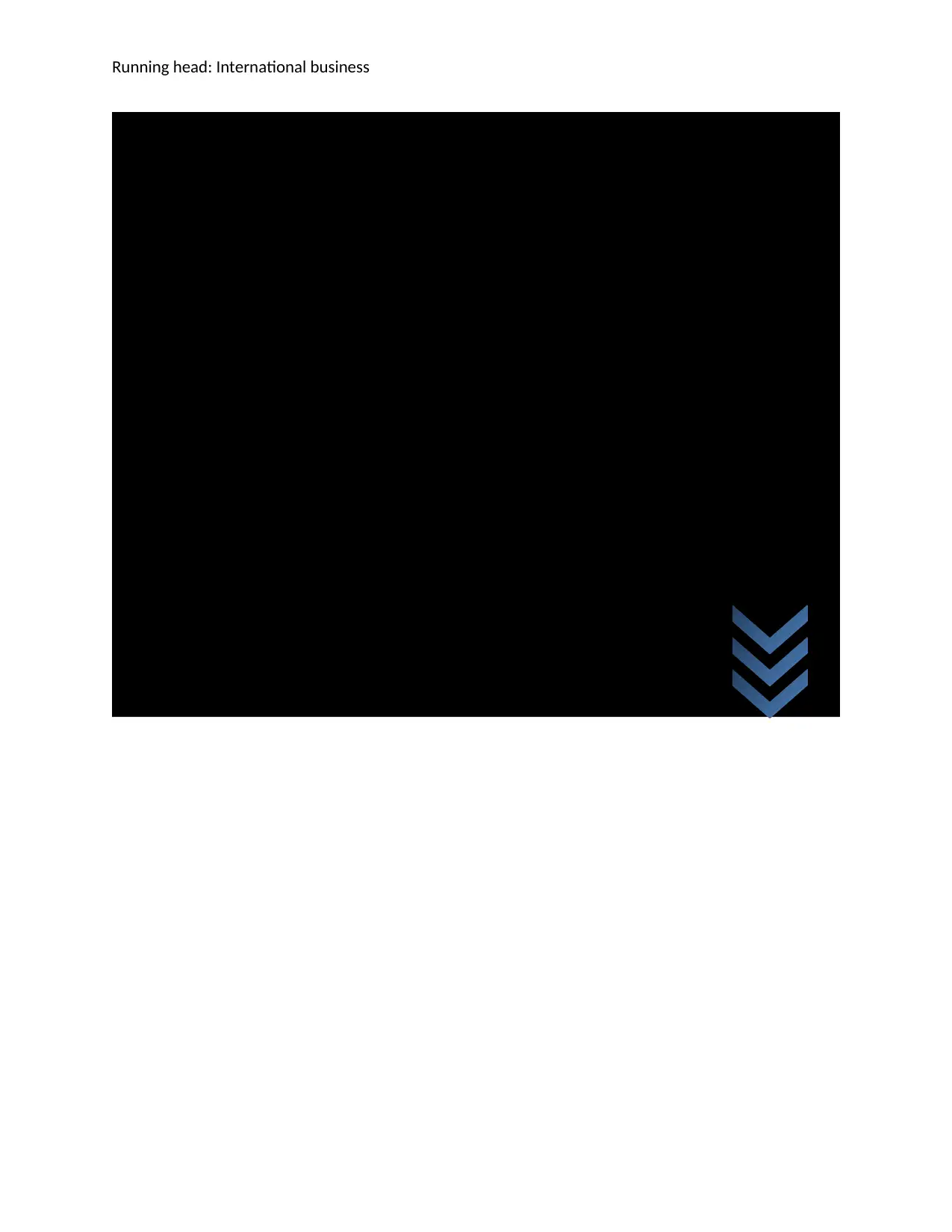
Running head: International business
Secure Best Marks with AI Grader
Need help grading? Try our AI Grader for instant feedback on your assignments.
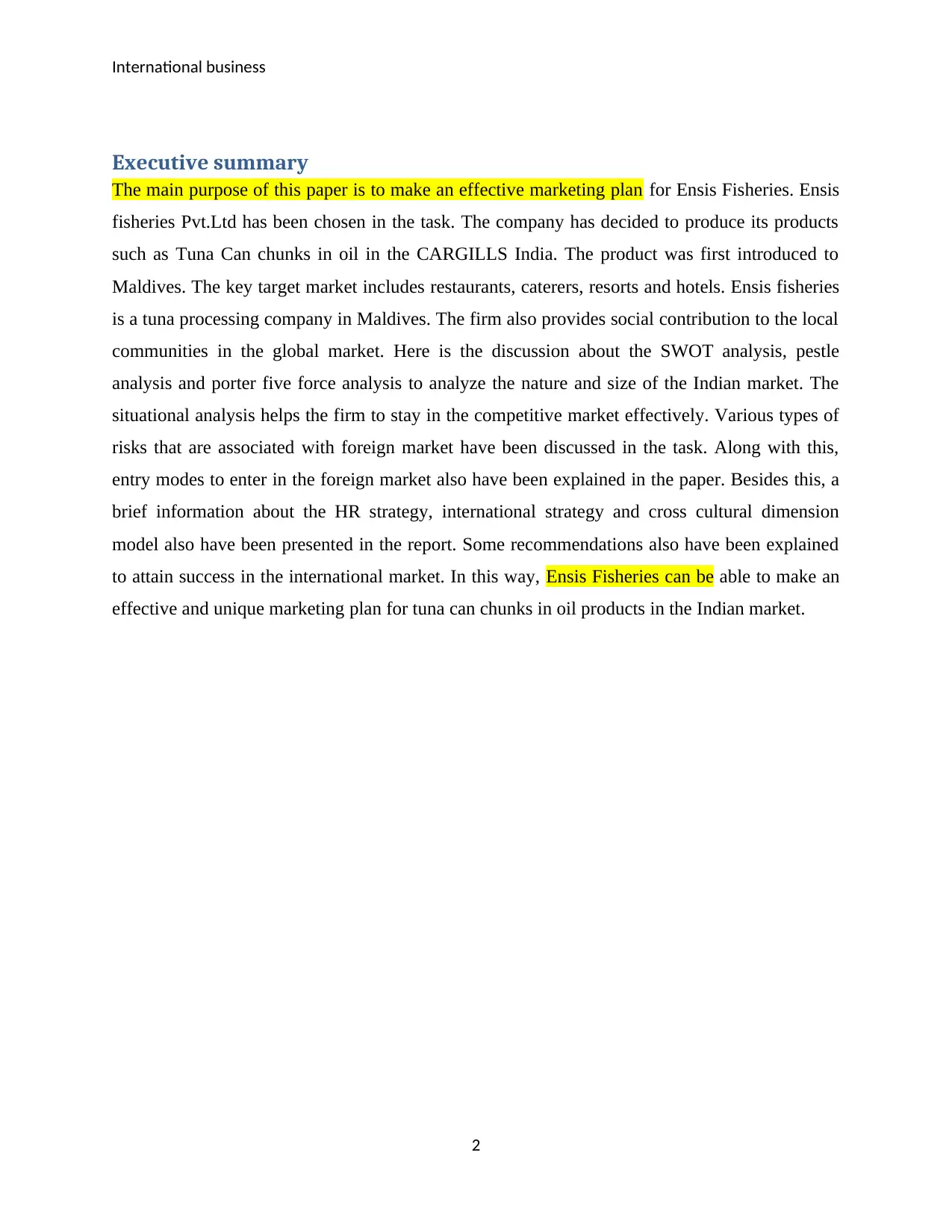
International business
Executive summary
The main purpose of this paper is to make an effective marketing plan for Ensis Fisheries. Ensis
fisheries Pvt.Ltd has been chosen in the task. The company has decided to produce its products
such as Tuna Can chunks in oil in the CARGILLS India. The product was first introduced to
Maldives. The key target market includes restaurants, caterers, resorts and hotels. Ensis fisheries
is a tuna processing company in Maldives. The firm also provides social contribution to the local
communities in the global market. Here is the discussion about the SWOT analysis, pestle
analysis and porter five force analysis to analyze the nature and size of the Indian market. The
situational analysis helps the firm to stay in the competitive market effectively. Various types of
risks that are associated with foreign market have been discussed in the task. Along with this,
entry modes to enter in the foreign market also have been explained in the paper. Besides this, a
brief information about the HR strategy, international strategy and cross cultural dimension
model also have been presented in the report. Some recommendations also have been explained
to attain success in the international market. In this way, Ensis Fisheries can be able to make an
effective and unique marketing plan for tuna can chunks in oil products in the Indian market.
2
Executive summary
The main purpose of this paper is to make an effective marketing plan for Ensis Fisheries. Ensis
fisheries Pvt.Ltd has been chosen in the task. The company has decided to produce its products
such as Tuna Can chunks in oil in the CARGILLS India. The product was first introduced to
Maldives. The key target market includes restaurants, caterers, resorts and hotels. Ensis fisheries
is a tuna processing company in Maldives. The firm also provides social contribution to the local
communities in the global market. Here is the discussion about the SWOT analysis, pestle
analysis and porter five force analysis to analyze the nature and size of the Indian market. The
situational analysis helps the firm to stay in the competitive market effectively. Various types of
risks that are associated with foreign market have been discussed in the task. Along with this,
entry modes to enter in the foreign market also have been explained in the paper. Besides this, a
brief information about the HR strategy, international strategy and cross cultural dimension
model also have been presented in the report. Some recommendations also have been explained
to attain success in the international market. In this way, Ensis Fisheries can be able to make an
effective and unique marketing plan for tuna can chunks in oil products in the Indian market.
2
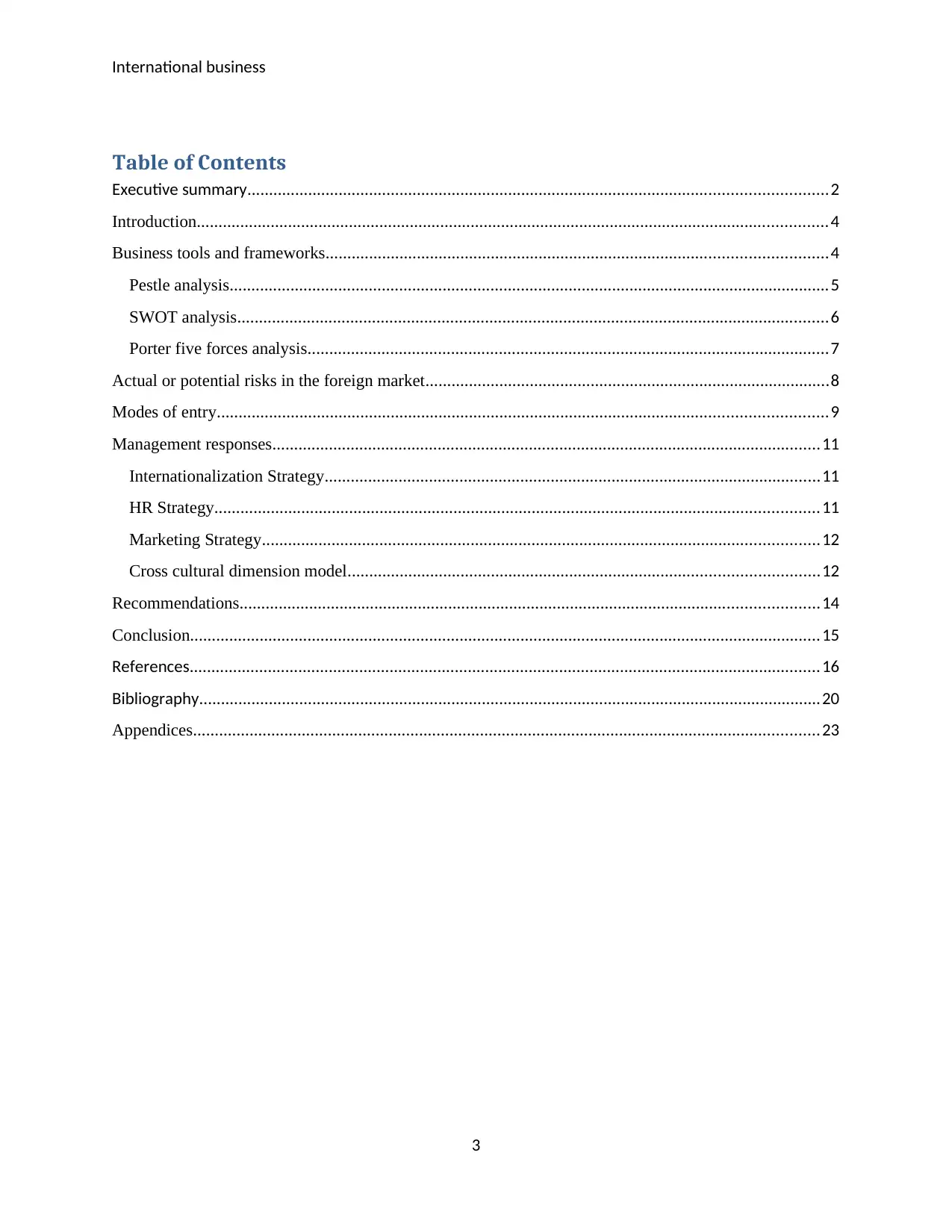
International business
Table of Contents
Executive summary.....................................................................................................................................2
Introduction.................................................................................................................................................4
Business tools and frameworks...................................................................................................................4
Pestle analysis..........................................................................................................................................5
SWOT analysis........................................................................................................................................6
Porter five forces analysis........................................................................................................................7
Actual or potential risks in the foreign market.............................................................................................8
Modes of entry............................................................................................................................................9
Management responses..............................................................................................................................11
Internationalization Strategy..................................................................................................................11
HR Strategy...........................................................................................................................................11
Marketing Strategy................................................................................................................................12
Cross cultural dimension model............................................................................................................12
Recommendations.....................................................................................................................................14
Conclusion.................................................................................................................................................15
References.................................................................................................................................................16
Bibliography...............................................................................................................................................20
Appendices................................................................................................................................................23
3
Table of Contents
Executive summary.....................................................................................................................................2
Introduction.................................................................................................................................................4
Business tools and frameworks...................................................................................................................4
Pestle analysis..........................................................................................................................................5
SWOT analysis........................................................................................................................................6
Porter five forces analysis........................................................................................................................7
Actual or potential risks in the foreign market.............................................................................................8
Modes of entry............................................................................................................................................9
Management responses..............................................................................................................................11
Internationalization Strategy..................................................................................................................11
HR Strategy...........................................................................................................................................11
Marketing Strategy................................................................................................................................12
Cross cultural dimension model............................................................................................................12
Recommendations.....................................................................................................................................14
Conclusion.................................................................................................................................................15
References.................................................................................................................................................16
Bibliography...............................................................................................................................................20
Appendices................................................................................................................................................23
3
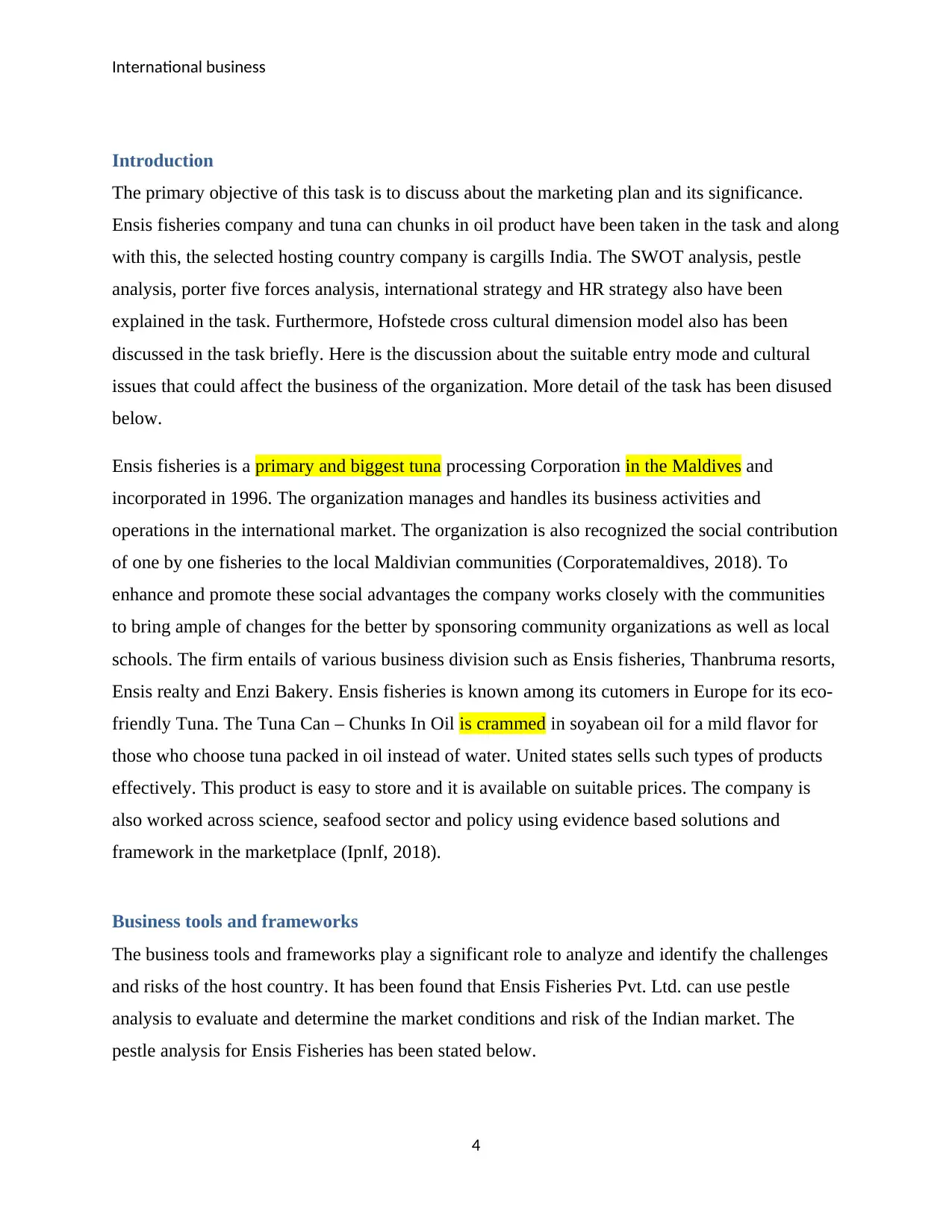
International business
Introduction
The primary objective of this task is to discuss about the marketing plan and its significance.
Ensis fisheries company and tuna can chunks in oil product have been taken in the task and along
with this, the selected hosting country company is cargills India. The SWOT analysis, pestle
analysis, porter five forces analysis, international strategy and HR strategy also have been
explained in the task. Furthermore, Hofstede cross cultural dimension model also has been
discussed in the task briefly. Here is the discussion about the suitable entry mode and cultural
issues that could affect the business of the organization. More detail of the task has been disused
below.
Ensis fisheries is a primary and biggest tuna processing Corporation in the Maldives and
incorporated in 1996. The organization manages and handles its business activities and
operations in the international market. The organization is also recognized the social contribution
of one by one fisheries to the local Maldivian communities (Corporatemaldives, 2018). To
enhance and promote these social advantages the company works closely with the communities
to bring ample of changes for the better by sponsoring community organizations as well as local
schools. The firm entails of various business division such as Ensis fisheries, Thanbruma resorts,
Ensis realty and Enzi Bakery. Ensis fisheries is known among its cutomers in Europe for its eco-
friendly Tuna. The Tuna Can – Chunks In Oil is crammed in soyabean oil for a mild flavor for
those who choose tuna packed in oil instead of water. United states sells such types of products
effectively. This product is easy to store and it is available on suitable prices. The company is
also worked across science, seafood sector and policy using evidence based solutions and
framework in the marketplace (Ipnlf, 2018).
Business tools and frameworks
The business tools and frameworks play a significant role to analyze and identify the challenges
and risks of the host country. It has been found that Ensis Fisheries Pvt. Ltd. can use pestle
analysis to evaluate and determine the market conditions and risk of the Indian market. The
pestle analysis for Ensis Fisheries has been stated below.
4
Introduction
The primary objective of this task is to discuss about the marketing plan and its significance.
Ensis fisheries company and tuna can chunks in oil product have been taken in the task and along
with this, the selected hosting country company is cargills India. The SWOT analysis, pestle
analysis, porter five forces analysis, international strategy and HR strategy also have been
explained in the task. Furthermore, Hofstede cross cultural dimension model also has been
discussed in the task briefly. Here is the discussion about the suitable entry mode and cultural
issues that could affect the business of the organization. More detail of the task has been disused
below.
Ensis fisheries is a primary and biggest tuna processing Corporation in the Maldives and
incorporated in 1996. The organization manages and handles its business activities and
operations in the international market. The organization is also recognized the social contribution
of one by one fisheries to the local Maldivian communities (Corporatemaldives, 2018). To
enhance and promote these social advantages the company works closely with the communities
to bring ample of changes for the better by sponsoring community organizations as well as local
schools. The firm entails of various business division such as Ensis fisheries, Thanbruma resorts,
Ensis realty and Enzi Bakery. Ensis fisheries is known among its cutomers in Europe for its eco-
friendly Tuna. The Tuna Can – Chunks In Oil is crammed in soyabean oil for a mild flavor for
those who choose tuna packed in oil instead of water. United states sells such types of products
effectively. This product is easy to store and it is available on suitable prices. The company is
also worked across science, seafood sector and policy using evidence based solutions and
framework in the marketplace (Ipnlf, 2018).
Business tools and frameworks
The business tools and frameworks play a significant role to analyze and identify the challenges
and risks of the host country. It has been found that Ensis Fisheries Pvt. Ltd. can use pestle
analysis to evaluate and determine the market conditions and risk of the Indian market. The
pestle analysis for Ensis Fisheries has been stated below.
4
Secure Best Marks with AI Grader
Need help grading? Try our AI Grader for instant feedback on your assignments.
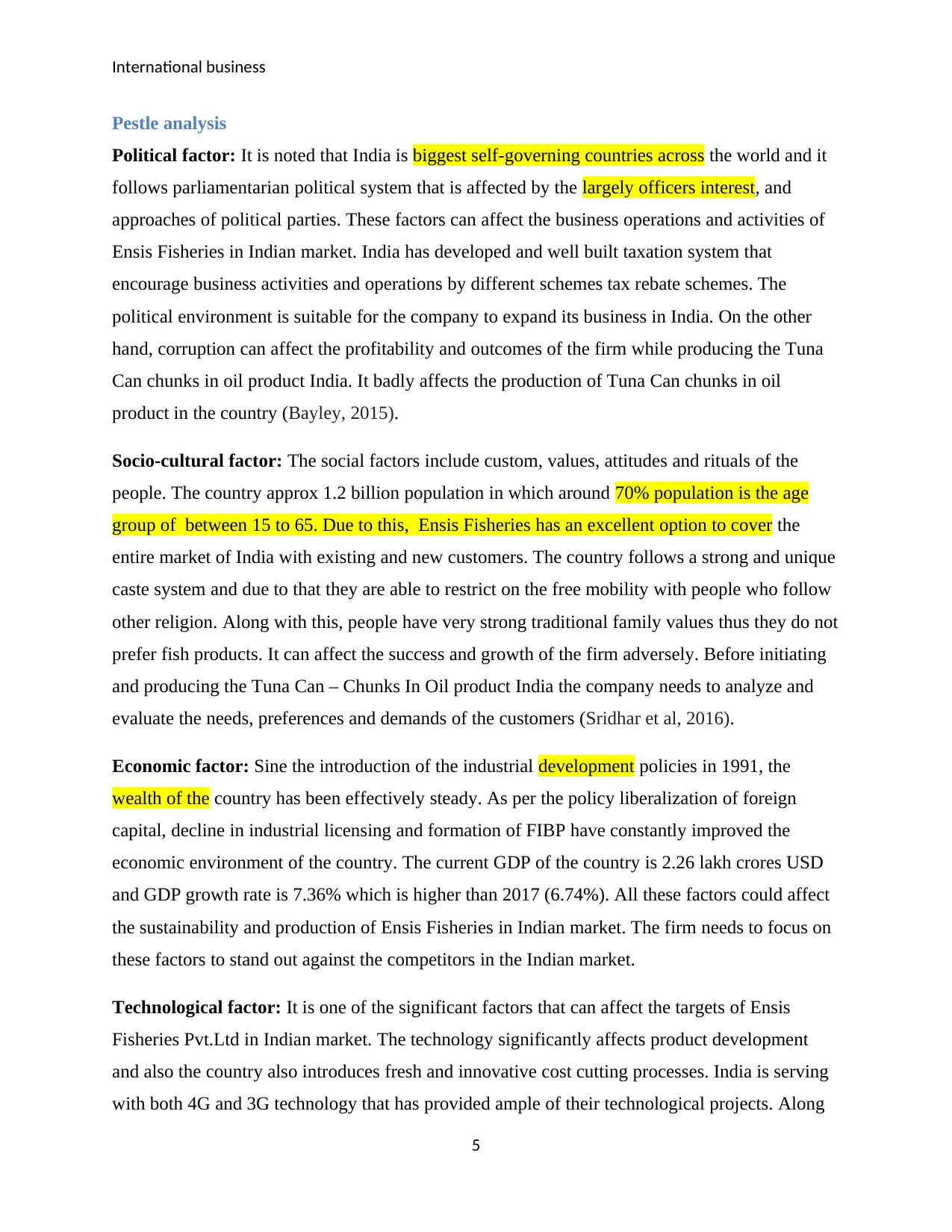
International business
Pestle analysis
Political factor: It is noted that India is biggest self-governing countries across the world and it
follows parliamentarian political system that is affected by the largely officers interest, and
approaches of political parties. These factors can affect the business operations and activities of
Ensis Fisheries in Indian market. India has developed and well built taxation system that
encourage business activities and operations by different schemes tax rebate schemes. The
political environment is suitable for the company to expand its business in India. On the other
hand, corruption can affect the profitability and outcomes of the firm while producing the Tuna
Can chunks in oil product India. It badly affects the production of Tuna Can chunks in oil
product in the country (Bayley, 2015).
Socio-cultural factor: The social factors include custom, values, attitudes and rituals of the
people. The country approx 1.2 billion population in which around 70% population is the age
group of between 15 to 65. Due to this, Ensis Fisheries has an excellent option to cover the
entire market of India with existing and new customers. The country follows a strong and unique
caste system and due to that they are able to restrict on the free mobility with people who follow
other religion. Along with this, people have very strong traditional family values thus they do not
prefer fish products. It can affect the success and growth of the firm adversely. Before initiating
and producing the Tuna Can – Chunks In Oil product India the company needs to analyze and
evaluate the needs, preferences and demands of the customers (Sridhar et al, 2016).
Economic factor: Sine the introduction of the industrial development policies in 1991, the
wealth of the country has been effectively steady. As per the policy liberalization of foreign
capital, decline in industrial licensing and formation of FIBP have constantly improved the
economic environment of the country. The current GDP of the country is 2.26 lakh crores USD
and GDP growth rate is 7.36% which is higher than 2017 (6.74%). All these factors could affect
the sustainability and production of Ensis Fisheries in Indian market. The firm needs to focus on
these factors to stand out against the competitors in the Indian market.
Technological factor: It is one of the significant factors that can affect the targets of Ensis
Fisheries Pvt.Ltd in Indian market. The technology significantly affects product development
and also the country also introduces fresh and innovative cost cutting processes. India is serving
with both 4G and 3G technology that has provided ample of their technological projects. Along
5
Pestle analysis
Political factor: It is noted that India is biggest self-governing countries across the world and it
follows parliamentarian political system that is affected by the largely officers interest, and
approaches of political parties. These factors can affect the business operations and activities of
Ensis Fisheries in Indian market. India has developed and well built taxation system that
encourage business activities and operations by different schemes tax rebate schemes. The
political environment is suitable for the company to expand its business in India. On the other
hand, corruption can affect the profitability and outcomes of the firm while producing the Tuna
Can chunks in oil product India. It badly affects the production of Tuna Can chunks in oil
product in the country (Bayley, 2015).
Socio-cultural factor: The social factors include custom, values, attitudes and rituals of the
people. The country approx 1.2 billion population in which around 70% population is the age
group of between 15 to 65. Due to this, Ensis Fisheries has an excellent option to cover the
entire market of India with existing and new customers. The country follows a strong and unique
caste system and due to that they are able to restrict on the free mobility with people who follow
other religion. Along with this, people have very strong traditional family values thus they do not
prefer fish products. It can affect the success and growth of the firm adversely. Before initiating
and producing the Tuna Can – Chunks In Oil product India the company needs to analyze and
evaluate the needs, preferences and demands of the customers (Sridhar et al, 2016).
Economic factor: Sine the introduction of the industrial development policies in 1991, the
wealth of the country has been effectively steady. As per the policy liberalization of foreign
capital, decline in industrial licensing and formation of FIBP have constantly improved the
economic environment of the country. The current GDP of the country is 2.26 lakh crores USD
and GDP growth rate is 7.36% which is higher than 2017 (6.74%). All these factors could affect
the sustainability and production of Ensis Fisheries in Indian market. The firm needs to focus on
these factors to stand out against the competitors in the Indian market.
Technological factor: It is one of the significant factors that can affect the targets of Ensis
Fisheries Pvt.Ltd in Indian market. The technology significantly affects product development
and also the country also introduces fresh and innovative cost cutting processes. India is serving
with both 4G and 3G technology that has provided ample of their technological projects. Along
5
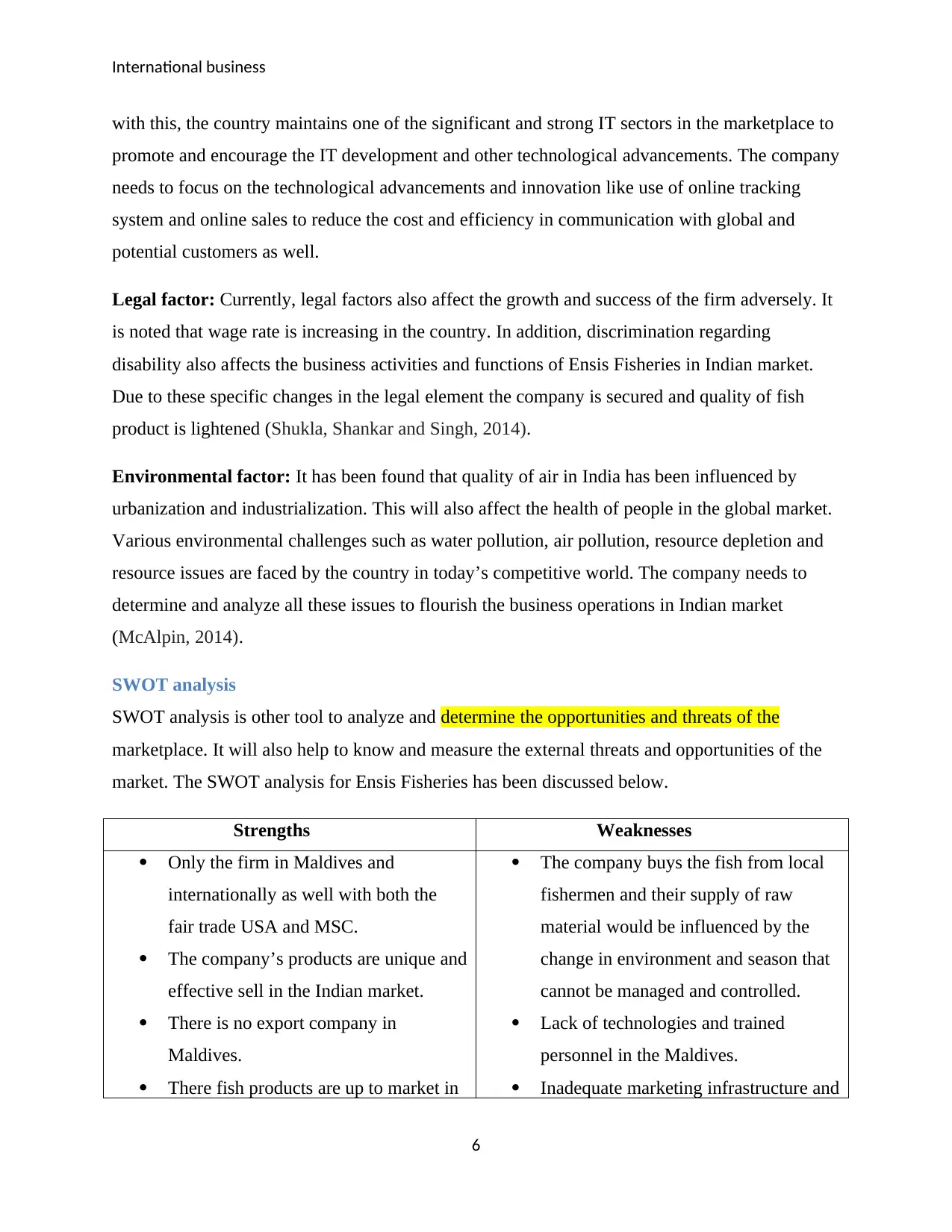
International business
with this, the country maintains one of the significant and strong IT sectors in the marketplace to
promote and encourage the IT development and other technological advancements. The company
needs to focus on the technological advancements and innovation like use of online tracking
system and online sales to reduce the cost and efficiency in communication with global and
potential customers as well.
Legal factor: Currently, legal factors also affect the growth and success of the firm adversely. It
is noted that wage rate is increasing in the country. In addition, discrimination regarding
disability also affects the business activities and functions of Ensis Fisheries in Indian market.
Due to these specific changes in the legal element the company is secured and quality of fish
product is lightened (Shukla, Shankar and Singh, 2014).
Environmental factor: It has been found that quality of air in India has been influenced by
urbanization and industrialization. This will also affect the health of people in the global market.
Various environmental challenges such as water pollution, air pollution, resource depletion and
resource issues are faced by the country in today’s competitive world. The company needs to
determine and analyze all these issues to flourish the business operations in Indian market
(McAlpin, 2014).
SWOT analysis
SWOT analysis is other tool to analyze and determine the opportunities and threats of the
marketplace. It will also help to know and measure the external threats and opportunities of the
market. The SWOT analysis for Ensis Fisheries has been discussed below.
Strengths Weaknesses
Only the firm in Maldives and
internationally as well with both the
fair trade USA and MSC.
The company’s products are unique and
effective sell in the Indian market.
There is no export company in
Maldives.
There fish products are up to market in
The company buys the fish from local
fishermen and their supply of raw
material would be influenced by the
change in environment and season that
cannot be managed and controlled.
Lack of technologies and trained
personnel in the Maldives.
Inadequate marketing infrastructure and
6
with this, the country maintains one of the significant and strong IT sectors in the marketplace to
promote and encourage the IT development and other technological advancements. The company
needs to focus on the technological advancements and innovation like use of online tracking
system and online sales to reduce the cost and efficiency in communication with global and
potential customers as well.
Legal factor: Currently, legal factors also affect the growth and success of the firm adversely. It
is noted that wage rate is increasing in the country. In addition, discrimination regarding
disability also affects the business activities and functions of Ensis Fisheries in Indian market.
Due to these specific changes in the legal element the company is secured and quality of fish
product is lightened (Shukla, Shankar and Singh, 2014).
Environmental factor: It has been found that quality of air in India has been influenced by
urbanization and industrialization. This will also affect the health of people in the global market.
Various environmental challenges such as water pollution, air pollution, resource depletion and
resource issues are faced by the country in today’s competitive world. The company needs to
determine and analyze all these issues to flourish the business operations in Indian market
(McAlpin, 2014).
SWOT analysis
SWOT analysis is other tool to analyze and determine the opportunities and threats of the
marketplace. It will also help to know and measure the external threats and opportunities of the
market. The SWOT analysis for Ensis Fisheries has been discussed below.
Strengths Weaknesses
Only the firm in Maldives and
internationally as well with both the
fair trade USA and MSC.
The company’s products are unique and
effective sell in the Indian market.
There is no export company in
Maldives.
There fish products are up to market in
The company buys the fish from local
fishermen and their supply of raw
material would be influenced by the
change in environment and season that
cannot be managed and controlled.
Lack of technologies and trained
personnel in the Maldives.
Inadequate marketing infrastructure and
6
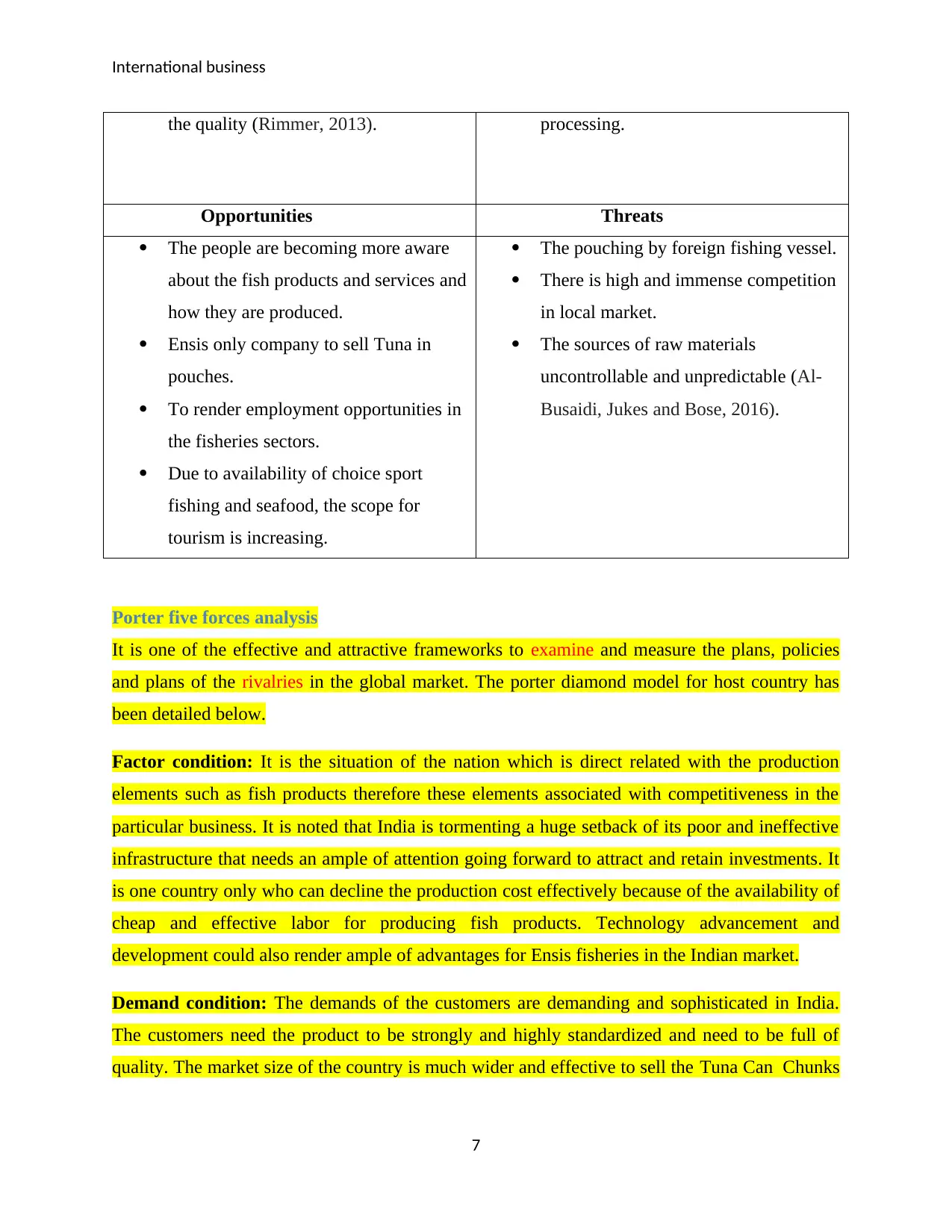
International business
the quality (Rimmer, 2013). processing.
Opportunities Threats
The people are becoming more aware
about the fish products and services and
how they are produced.
Ensis only company to sell Tuna in
pouches.
To render employment opportunities in
the fisheries sectors.
Due to availability of choice sport
fishing and seafood, the scope for
tourism is increasing.
The pouching by foreign fishing vessel.
There is high and immense competition
in local market.
The sources of raw materials
uncontrollable and unpredictable (Al-
Busaidi, Jukes and Bose, 2016).
Porter five forces analysis
It is one of the effective and attractive frameworks to examine and measure the plans, policies
and plans of the rivalries in the global market. The porter diamond model for host country has
been detailed below.
Factor condition: It is the situation of the nation which is direct related with the production
elements such as fish products therefore these elements associated with competitiveness in the
particular business. It is noted that India is tormenting a huge setback of its poor and ineffective
infrastructure that needs an ample of attention going forward to attract and retain investments. It
is one country only who can decline the production cost effectively because of the availability of
cheap and effective labor for producing fish products. Technology advancement and
development could also render ample of advantages for Ensis fisheries in the Indian market.
Demand condition: The demands of the customers are demanding and sophisticated in India.
The customers need the product to be strongly and highly standardized and need to be full of
quality. The market size of the country is much wider and effective to sell the Tuna Can Chunks
7
the quality (Rimmer, 2013). processing.
Opportunities Threats
The people are becoming more aware
about the fish products and services and
how they are produced.
Ensis only company to sell Tuna in
pouches.
To render employment opportunities in
the fisheries sectors.
Due to availability of choice sport
fishing and seafood, the scope for
tourism is increasing.
The pouching by foreign fishing vessel.
There is high and immense competition
in local market.
The sources of raw materials
uncontrollable and unpredictable (Al-
Busaidi, Jukes and Bose, 2016).
Porter five forces analysis
It is one of the effective and attractive frameworks to examine and measure the plans, policies
and plans of the rivalries in the global market. The porter diamond model for host country has
been detailed below.
Factor condition: It is the situation of the nation which is direct related with the production
elements such as fish products therefore these elements associated with competitiveness in the
particular business. It is noted that India is tormenting a huge setback of its poor and ineffective
infrastructure that needs an ample of attention going forward to attract and retain investments. It
is one country only who can decline the production cost effectively because of the availability of
cheap and effective labor for producing fish products. Technology advancement and
development could also render ample of advantages for Ensis fisheries in the Indian market.
Demand condition: The demands of the customers are demanding and sophisticated in India.
The customers need the product to be strongly and highly standardized and need to be full of
quality. The market size of the country is much wider and effective to sell the Tuna Can Chunks
7
Paraphrase This Document
Need a fresh take? Get an instant paraphrase of this document with our AI Paraphraser
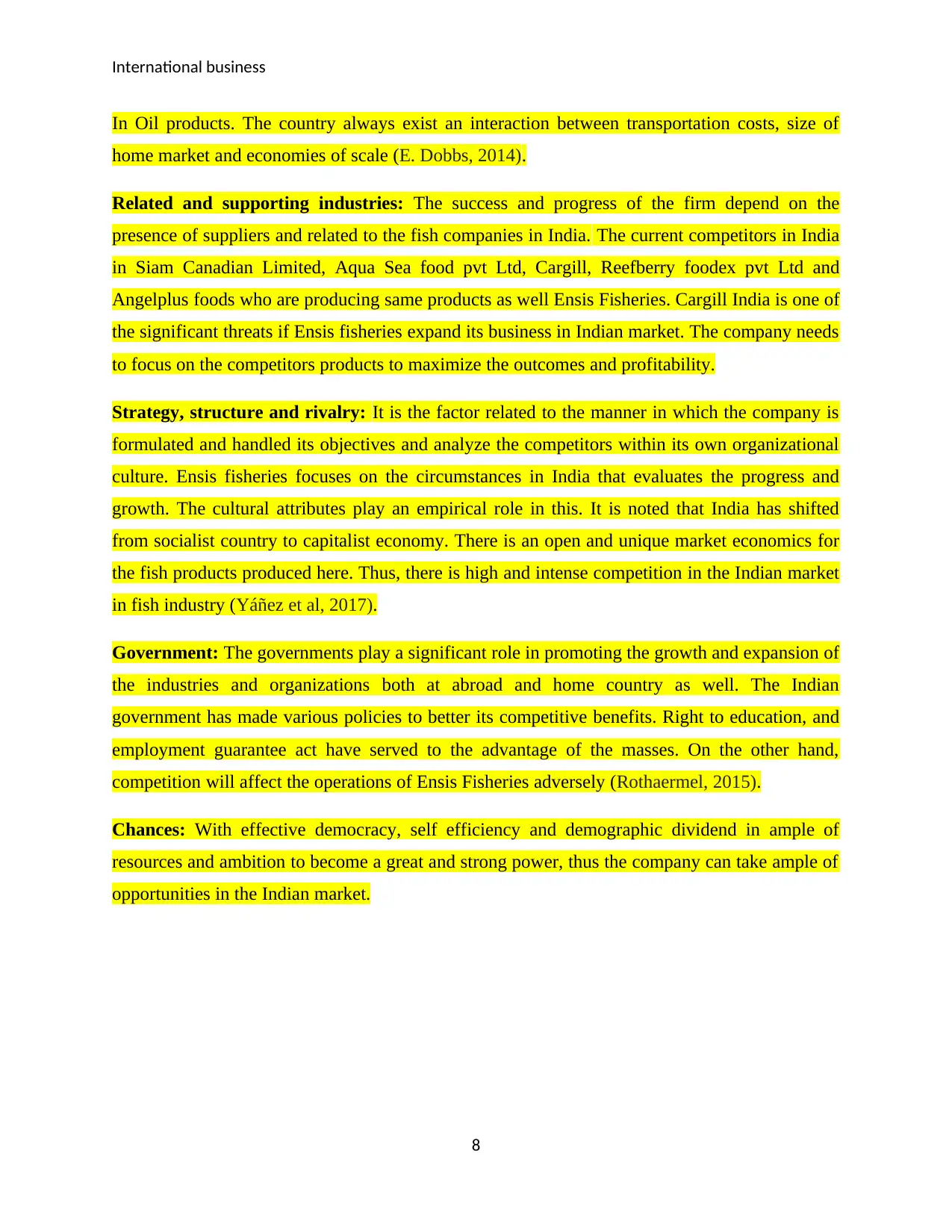
International business
In Oil products. The country always exist an interaction between transportation costs, size of
home market and economies of scale (E. Dobbs, 2014).
Related and supporting industries: The success and progress of the firm depend on the
presence of suppliers and related to the fish companies in India. The current competitors in India
in Siam Canadian Limited, Aqua Sea food pvt Ltd, Cargill, Reefberry foodex pvt Ltd and
Angelplus foods who are producing same products as well Ensis Fisheries. Cargill India is one of
the significant threats if Ensis fisheries expand its business in Indian market. The company needs
to focus on the competitors products to maximize the outcomes and profitability.
Strategy, structure and rivalry: It is the factor related to the manner in which the company is
formulated and handled its objectives and analyze the competitors within its own organizational
culture. Ensis fisheries focuses on the circumstances in India that evaluates the progress and
growth. The cultural attributes play an empirical role in this. It is noted that India has shifted
from socialist country to capitalist economy. There is an open and unique market economics for
the fish products produced here. Thus, there is high and intense competition in the Indian market
in fish industry (Yáñez et al, 2017).
Government: The governments play a significant role in promoting the growth and expansion of
the industries and organizations both at abroad and home country as well. The Indian
government has made various policies to better its competitive benefits. Right to education, and
employment guarantee act have served to the advantage of the masses. On the other hand,
competition will affect the operations of Ensis Fisheries adversely (Rothaermel, 2015).
Chances: With effective democracy, self efficiency and demographic dividend in ample of
resources and ambition to become a great and strong power, thus the company can take ample of
opportunities in the Indian market.
8
In Oil products. The country always exist an interaction between transportation costs, size of
home market and economies of scale (E. Dobbs, 2014).
Related and supporting industries: The success and progress of the firm depend on the
presence of suppliers and related to the fish companies in India. The current competitors in India
in Siam Canadian Limited, Aqua Sea food pvt Ltd, Cargill, Reefberry foodex pvt Ltd and
Angelplus foods who are producing same products as well Ensis Fisheries. Cargill India is one of
the significant threats if Ensis fisheries expand its business in Indian market. The company needs
to focus on the competitors products to maximize the outcomes and profitability.
Strategy, structure and rivalry: It is the factor related to the manner in which the company is
formulated and handled its objectives and analyze the competitors within its own organizational
culture. Ensis fisheries focuses on the circumstances in India that evaluates the progress and
growth. The cultural attributes play an empirical role in this. It is noted that India has shifted
from socialist country to capitalist economy. There is an open and unique market economics for
the fish products produced here. Thus, there is high and intense competition in the Indian market
in fish industry (Yáñez et al, 2017).
Government: The governments play a significant role in promoting the growth and expansion of
the industries and organizations both at abroad and home country as well. The Indian
government has made various policies to better its competitive benefits. Right to education, and
employment guarantee act have served to the advantage of the masses. On the other hand,
competition will affect the operations of Ensis Fisheries adversely (Rothaermel, 2015).
Chances: With effective democracy, self efficiency and demographic dividend in ample of
resources and ambition to become a great and strong power, thus the company can take ample of
opportunities in the Indian market.
8
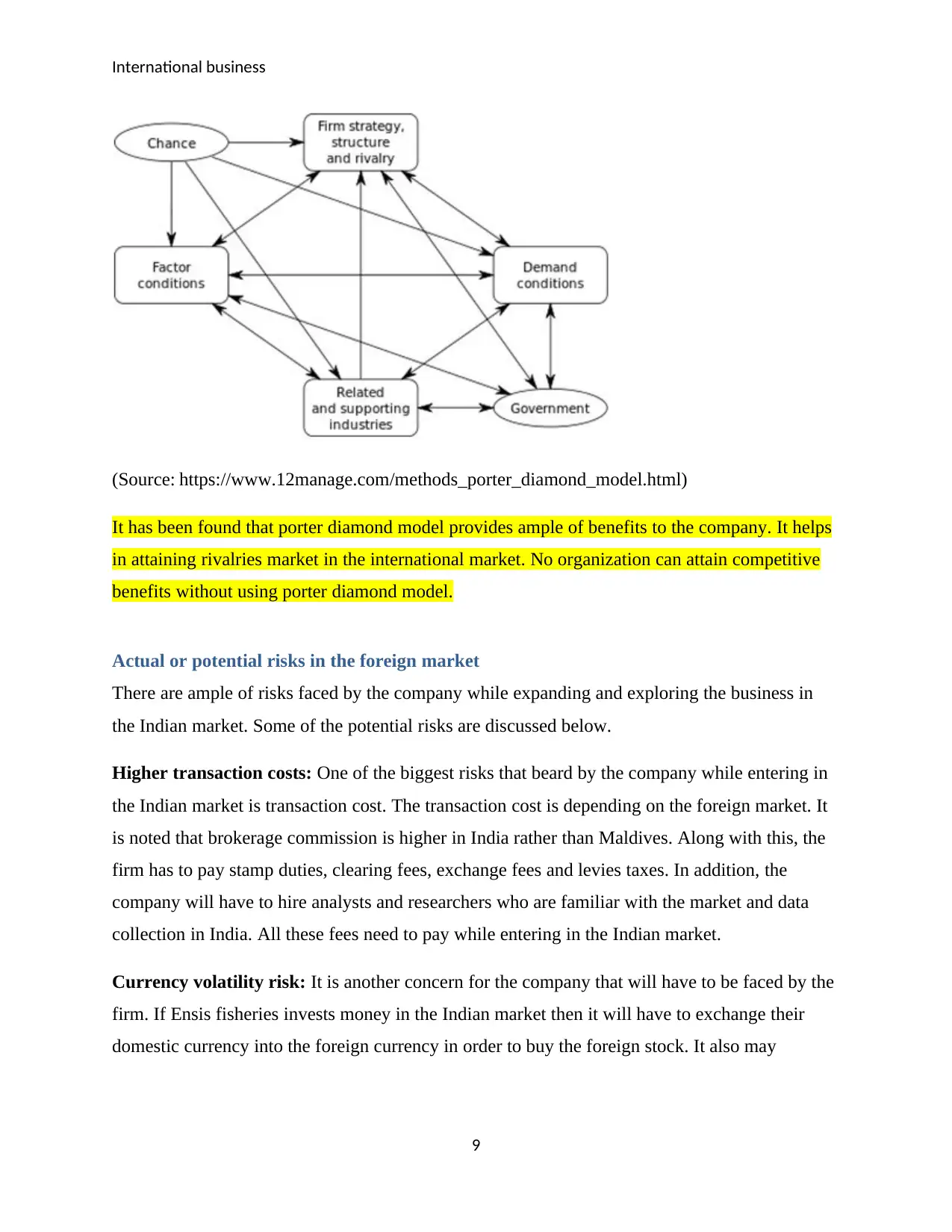
International business
(Source: https://www.12manage.com/methods_porter_diamond_model.html)
It has been found that porter diamond model provides ample of benefits to the company. It helps
in attaining rivalries market in the international market. No organization can attain competitive
benefits without using porter diamond model.
Actual or potential risks in the foreign market
There are ample of risks faced by the company while expanding and exploring the business in
the Indian market. Some of the potential risks are discussed below.
Higher transaction costs: One of the biggest risks that beard by the company while entering in
the Indian market is transaction cost. The transaction cost is depending on the foreign market. It
is noted that brokerage commission is higher in India rather than Maldives. Along with this, the
firm has to pay stamp duties, clearing fees, exchange fees and levies taxes. In addition, the
company will have to hire analysts and researchers who are familiar with the market and data
collection in India. All these fees need to pay while entering in the Indian market.
Currency volatility risk: It is another concern for the company that will have to be faced by the
firm. If Ensis fisheries invests money in the Indian market then it will have to exchange their
domestic currency into the foreign currency in order to buy the foreign stock. It also may
9
(Source: https://www.12manage.com/methods_porter_diamond_model.html)
It has been found that porter diamond model provides ample of benefits to the company. It helps
in attaining rivalries market in the international market. No organization can attain competitive
benefits without using porter diamond model.
Actual or potential risks in the foreign market
There are ample of risks faced by the company while expanding and exploring the business in
the Indian market. Some of the potential risks are discussed below.
Higher transaction costs: One of the biggest risks that beard by the company while entering in
the Indian market is transaction cost. The transaction cost is depending on the foreign market. It
is noted that brokerage commission is higher in India rather than Maldives. Along with this, the
firm has to pay stamp duties, clearing fees, exchange fees and levies taxes. In addition, the
company will have to hire analysts and researchers who are familiar with the market and data
collection in India. All these fees need to pay while entering in the Indian market.
Currency volatility risk: It is another concern for the company that will have to be faced by the
firm. If Ensis fisheries invests money in the Indian market then it will have to exchange their
domestic currency into the foreign currency in order to buy the foreign stock. It also may
9
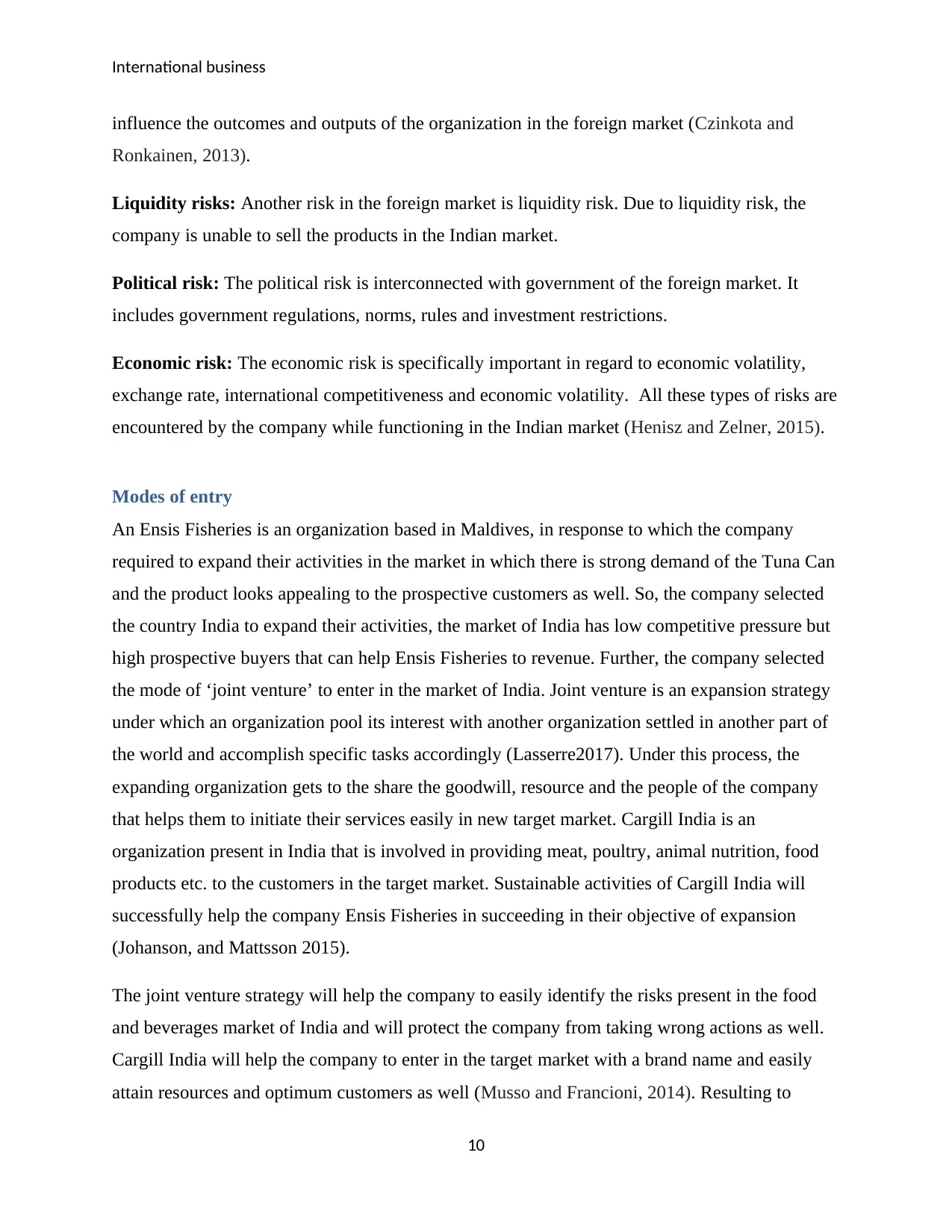
International business
influence the outcomes and outputs of the organization in the foreign market (Czinkota and
Ronkainen, 2013).
Liquidity risks: Another risk in the foreign market is liquidity risk. Due to liquidity risk, the
company is unable to sell the products in the Indian market.
Political risk: The political risk is interconnected with government of the foreign market. It
includes government regulations, norms, rules and investment restrictions.
Economic risk: The economic risk is specifically important in regard to economic volatility,
exchange rate, international competitiveness and economic volatility. All these types of risks are
encountered by the company while functioning in the Indian market (Henisz and Zelner, 2015).
Modes of entry
An Ensis Fisheries is an organization based in Maldives, in response to which the company
required to expand their activities in the market in which there is strong demand of the Tuna Can
and the product looks appealing to the prospective customers as well. So, the company selected
the country India to expand their activities, the market of India has low competitive pressure but
high prospective buyers that can help Ensis Fisheries to revenue. Further, the company selected
the mode of ‘joint venture’ to enter in the market of India. Joint venture is an expansion strategy
under which an organization pool its interest with another organization settled in another part of
the world and accomplish specific tasks accordingly (Lasserre2017). Under this process, the
expanding organization gets to the share the goodwill, resource and the people of the company
that helps them to initiate their services easily in new target market. Cargill India is an
organization present in India that is involved in providing meat, poultry, animal nutrition, food
products etc. to the customers in the target market. Sustainable activities of Cargill India will
successfully help the company Ensis Fisheries in succeeding in their objective of expansion
(Johanson, and Mattsson 2015).
The joint venture strategy will help the company to easily identify the risks present in the food
and beverages market of India and will protect the company from taking wrong actions as well.
Cargill India will help the company to enter in the target market with a brand name and easily
attain resources and optimum customers as well (Musso and Francioni, 2014). Resulting to
10
influence the outcomes and outputs of the organization in the foreign market (Czinkota and
Ronkainen, 2013).
Liquidity risks: Another risk in the foreign market is liquidity risk. Due to liquidity risk, the
company is unable to sell the products in the Indian market.
Political risk: The political risk is interconnected with government of the foreign market. It
includes government regulations, norms, rules and investment restrictions.
Economic risk: The economic risk is specifically important in regard to economic volatility,
exchange rate, international competitiveness and economic volatility. All these types of risks are
encountered by the company while functioning in the Indian market (Henisz and Zelner, 2015).
Modes of entry
An Ensis Fisheries is an organization based in Maldives, in response to which the company
required to expand their activities in the market in which there is strong demand of the Tuna Can
and the product looks appealing to the prospective customers as well. So, the company selected
the country India to expand their activities, the market of India has low competitive pressure but
high prospective buyers that can help Ensis Fisheries to revenue. Further, the company selected
the mode of ‘joint venture’ to enter in the market of India. Joint venture is an expansion strategy
under which an organization pool its interest with another organization settled in another part of
the world and accomplish specific tasks accordingly (Lasserre2017). Under this process, the
expanding organization gets to the share the goodwill, resource and the people of the company
that helps them to initiate their services easily in new target market. Cargill India is an
organization present in India that is involved in providing meat, poultry, animal nutrition, food
products etc. to the customers in the target market. Sustainable activities of Cargill India will
successfully help the company Ensis Fisheries in succeeding in their objective of expansion
(Johanson, and Mattsson 2015).
The joint venture strategy will help the company to easily identify the risks present in the food
and beverages market of India and will protect the company from taking wrong actions as well.
Cargill India will help the company to enter in the target market with a brand name and easily
attain resources and optimum customers as well (Musso and Francioni, 2014). Resulting to
10
Secure Best Marks with AI Grader
Need help grading? Try our AI Grader for instant feedback on your assignments.
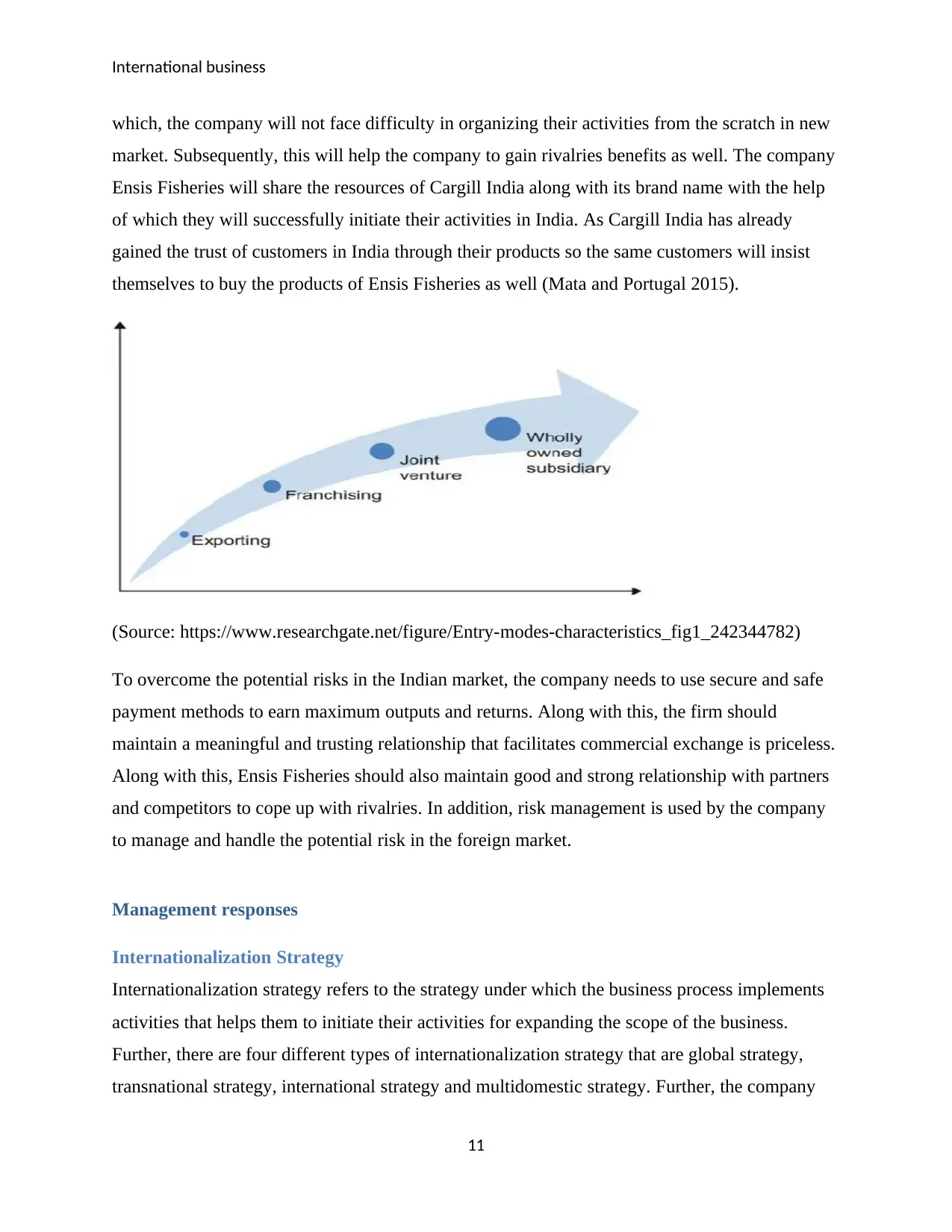
International business
which, the company will not face difficulty in organizing their activities from the scratch in new
market. Subsequently, this will help the company to gain rivalries benefits as well. The company
Ensis Fisheries will share the resources of Cargill India along with its brand name with the help
of which they will successfully initiate their activities in India. As Cargill India has already
gained the trust of customers in India through their products so the same customers will insist
themselves to buy the products of Ensis Fisheries as well (Mata and Portugal 2015).
(Source: https://www.researchgate.net/figure/Entry-modes-characteristics_fig1_242344782)
To overcome the potential risks in the Indian market, the company needs to use secure and safe
payment methods to earn maximum outputs and returns. Along with this, the firm should
maintain a meaningful and trusting relationship that facilitates commercial exchange is priceless.
Along with this, Ensis Fisheries should also maintain good and strong relationship with partners
and competitors to cope up with rivalries. In addition, risk management is used by the company
to manage and handle the potential risk in the foreign market.
Management responses
Internationalization Strategy
Internationalization strategy refers to the strategy under which the business process implements
activities that helps them to initiate their activities for expanding the scope of the business.
Further, there are four different types of internationalization strategy that are global strategy,
transnational strategy, international strategy and multidomestic strategy. Further, the company
11
which, the company will not face difficulty in organizing their activities from the scratch in new
market. Subsequently, this will help the company to gain rivalries benefits as well. The company
Ensis Fisheries will share the resources of Cargill India along with its brand name with the help
of which they will successfully initiate their activities in India. As Cargill India has already
gained the trust of customers in India through their products so the same customers will insist
themselves to buy the products of Ensis Fisheries as well (Mata and Portugal 2015).
(Source: https://www.researchgate.net/figure/Entry-modes-characteristics_fig1_242344782)
To overcome the potential risks in the Indian market, the company needs to use secure and safe
payment methods to earn maximum outputs and returns. Along with this, the firm should
maintain a meaningful and trusting relationship that facilitates commercial exchange is priceless.
Along with this, Ensis Fisheries should also maintain good and strong relationship with partners
and competitors to cope up with rivalries. In addition, risk management is used by the company
to manage and handle the potential risk in the foreign market.
Management responses
Internationalization Strategy
Internationalization strategy refers to the strategy under which the business process implements
activities that helps them to initiate their activities for expanding the scope of the business.
Further, there are four different types of internationalization strategy that are global strategy,
transnational strategy, international strategy and multidomestic strategy. Further, the company
11
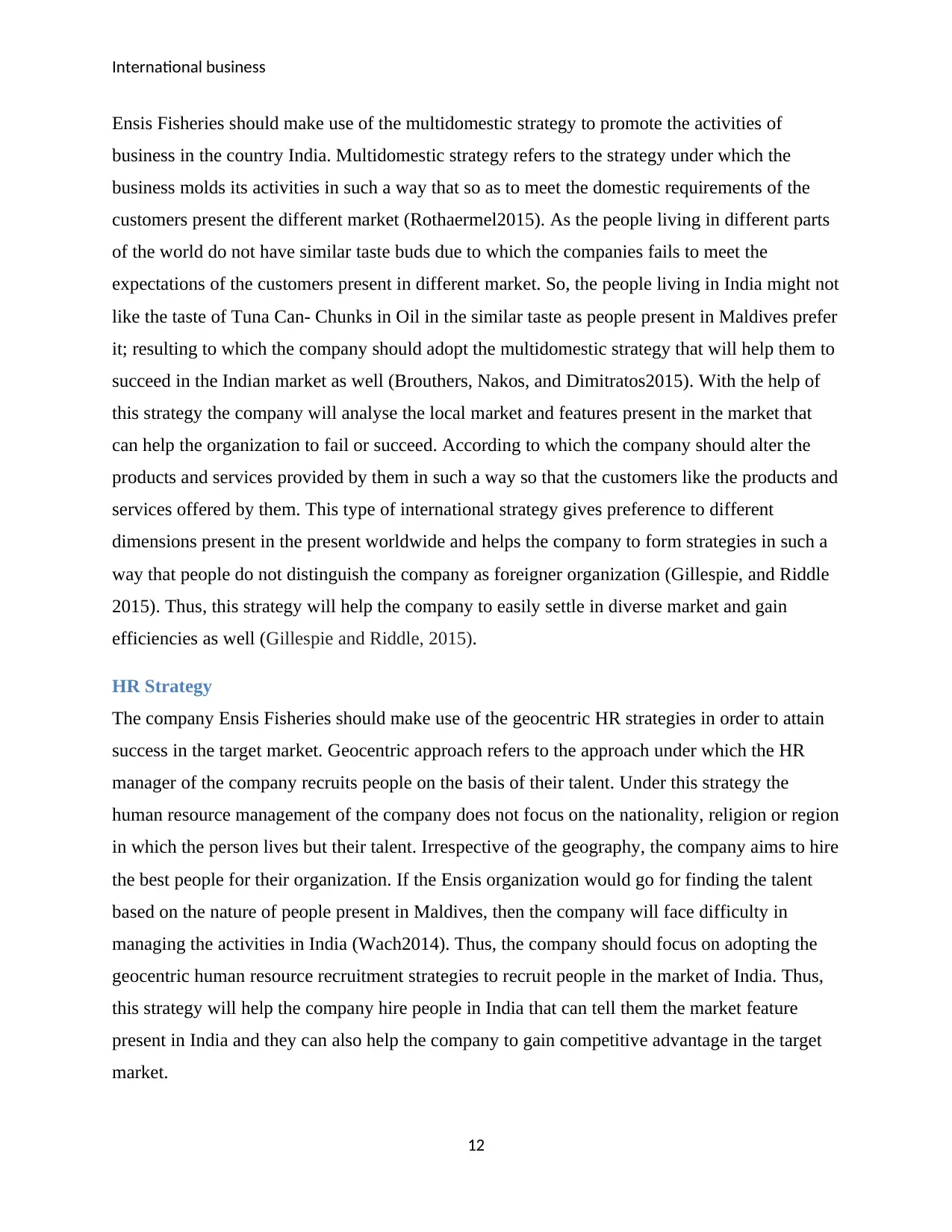
International business
Ensis Fisheries should make use of the multidomestic strategy to promote the activities of
business in the country India. Multidomestic strategy refers to the strategy under which the
business molds its activities in such a way that so as to meet the domestic requirements of the
customers present the different market (Rothaermel2015). As the people living in different parts
of the world do not have similar taste buds due to which the companies fails to meet the
expectations of the customers present in different market. So, the people living in India might not
like the taste of Tuna Can- Chunks in Oil in the similar taste as people present in Maldives prefer
it; resulting to which the company should adopt the multidomestic strategy that will help them to
succeed in the Indian market as well (Brouthers, Nakos, and Dimitratos2015). With the help of
this strategy the company will analyse the local market and features present in the market that
can help the organization to fail or succeed. According to which the company should alter the
products and services provided by them in such a way so that the customers like the products and
services offered by them. This type of international strategy gives preference to different
dimensions present in the present worldwide and helps the company to form strategies in such a
way that people do not distinguish the company as foreigner organization (Gillespie, and Riddle
2015). Thus, this strategy will help the company to easily settle in diverse market and gain
efficiencies as well (Gillespie and Riddle, 2015).
HR Strategy
The company Ensis Fisheries should make use of the geocentric HR strategies in order to attain
success in the target market. Geocentric approach refers to the approach under which the HR
manager of the company recruits people on the basis of their talent. Under this strategy the
human resource management of the company does not focus on the nationality, religion or region
in which the person lives but their talent. Irrespective of the geography, the company aims to hire
the best people for their organization. If the Ensis organization would go for finding the talent
based on the nature of people present in Maldives, then the company will face difficulty in
managing the activities in India (Wach2014). Thus, the company should focus on adopting the
geocentric human resource recruitment strategies to recruit people in the market of India. Thus,
this strategy will help the company hire people in India that can tell them the market feature
present in India and they can also help the company to gain competitive advantage in the target
market.
12
Ensis Fisheries should make use of the multidomestic strategy to promote the activities of
business in the country India. Multidomestic strategy refers to the strategy under which the
business molds its activities in such a way that so as to meet the domestic requirements of the
customers present the different market (Rothaermel2015). As the people living in different parts
of the world do not have similar taste buds due to which the companies fails to meet the
expectations of the customers present in different market. So, the people living in India might not
like the taste of Tuna Can- Chunks in Oil in the similar taste as people present in Maldives prefer
it; resulting to which the company should adopt the multidomestic strategy that will help them to
succeed in the Indian market as well (Brouthers, Nakos, and Dimitratos2015). With the help of
this strategy the company will analyse the local market and features present in the market that
can help the organization to fail or succeed. According to which the company should alter the
products and services provided by them in such a way so that the customers like the products and
services offered by them. This type of international strategy gives preference to different
dimensions present in the present worldwide and helps the company to form strategies in such a
way that people do not distinguish the company as foreigner organization (Gillespie, and Riddle
2015). Thus, this strategy will help the company to easily settle in diverse market and gain
efficiencies as well (Gillespie and Riddle, 2015).
HR Strategy
The company Ensis Fisheries should make use of the geocentric HR strategies in order to attain
success in the target market. Geocentric approach refers to the approach under which the HR
manager of the company recruits people on the basis of their talent. Under this strategy the
human resource management of the company does not focus on the nationality, religion or region
in which the person lives but their talent. Irrespective of the geography, the company aims to hire
the best people for their organization. If the Ensis organization would go for finding the talent
based on the nature of people present in Maldives, then the company will face difficulty in
managing the activities in India (Wach2014). Thus, the company should focus on adopting the
geocentric human resource recruitment strategies to recruit people in the market of India. Thus,
this strategy will help the company hire people in India that can tell them the market feature
present in India and they can also help the company to gain competitive advantage in the target
market.
12
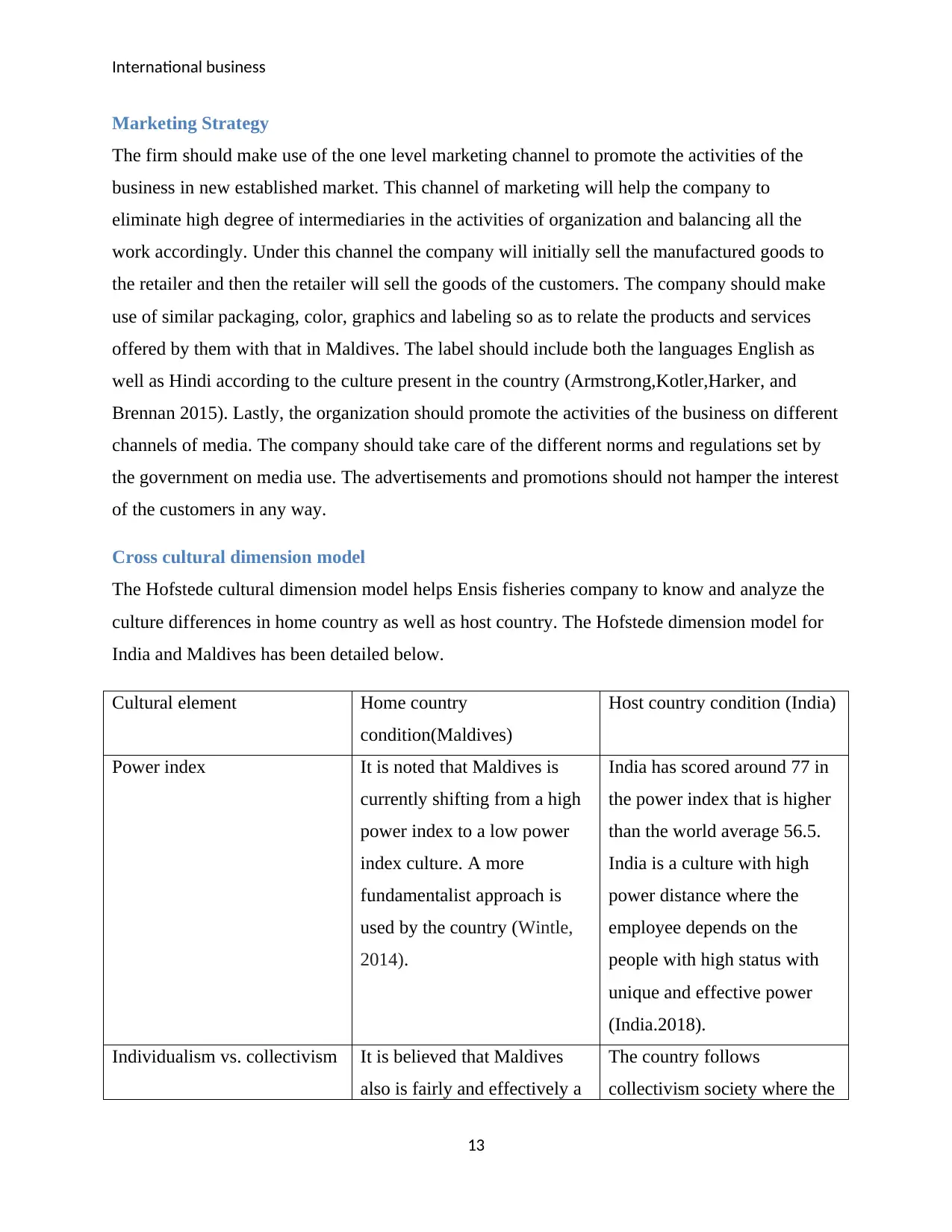
International business
Marketing Strategy
The firm should make use of the one level marketing channel to promote the activities of the
business in new established market. This channel of marketing will help the company to
eliminate high degree of intermediaries in the activities of organization and balancing all the
work accordingly. Under this channel the company will initially sell the manufactured goods to
the retailer and then the retailer will sell the goods of the customers. The company should make
use of similar packaging, color, graphics and labeling so as to relate the products and services
offered by them with that in Maldives. The label should include both the languages English as
well as Hindi according to the culture present in the country (Armstrong,Kotler,Harker, and
Brennan 2015). Lastly, the organization should promote the activities of the business on different
channels of media. The company should take care of the different norms and regulations set by
the government on media use. The advertisements and promotions should not hamper the interest
of the customers in any way.
Cross cultural dimension model
The Hofstede cultural dimension model helps Ensis fisheries company to know and analyze the
culture differences in home country as well as host country. The Hofstede dimension model for
India and Maldives has been detailed below.
Cultural element Home country
condition(Maldives)
Host country condition (India)
Power index It is noted that Maldives is
currently shifting from a high
power index to a low power
index culture. A more
fundamentalist approach is
used by the country (Wintle,
2014).
India has scored around 77 in
the power index that is higher
than the world average 56.5.
India is a culture with high
power distance where the
employee depends on the
people with high status with
unique and effective power
(India.2018).
Individualism vs. collectivism It is believed that Maldives
also is fairly and effectively a
The country follows
collectivism society where the
13
Marketing Strategy
The firm should make use of the one level marketing channel to promote the activities of the
business in new established market. This channel of marketing will help the company to
eliminate high degree of intermediaries in the activities of organization and balancing all the
work accordingly. Under this channel the company will initially sell the manufactured goods to
the retailer and then the retailer will sell the goods of the customers. The company should make
use of similar packaging, color, graphics and labeling so as to relate the products and services
offered by them with that in Maldives. The label should include both the languages English as
well as Hindi according to the culture present in the country (Armstrong,Kotler,Harker, and
Brennan 2015). Lastly, the organization should promote the activities of the business on different
channels of media. The company should take care of the different norms and regulations set by
the government on media use. The advertisements and promotions should not hamper the interest
of the customers in any way.
Cross cultural dimension model
The Hofstede cultural dimension model helps Ensis fisheries company to know and analyze the
culture differences in home country as well as host country. The Hofstede dimension model for
India and Maldives has been detailed below.
Cultural element Home country
condition(Maldives)
Host country condition (India)
Power index It is noted that Maldives is
currently shifting from a high
power index to a low power
index culture. A more
fundamentalist approach is
used by the country (Wintle,
2014).
India has scored around 77 in
the power index that is higher
than the world average 56.5.
India is a culture with high
power distance where the
employee depends on the
people with high status with
unique and effective power
(India.2018).
Individualism vs. collectivism It is believed that Maldives
also is fairly and effectively a
The country follows
collectivism society where the
13
Paraphrase This Document
Need a fresh take? Get an instant paraphrase of this document with our AI Paraphraser
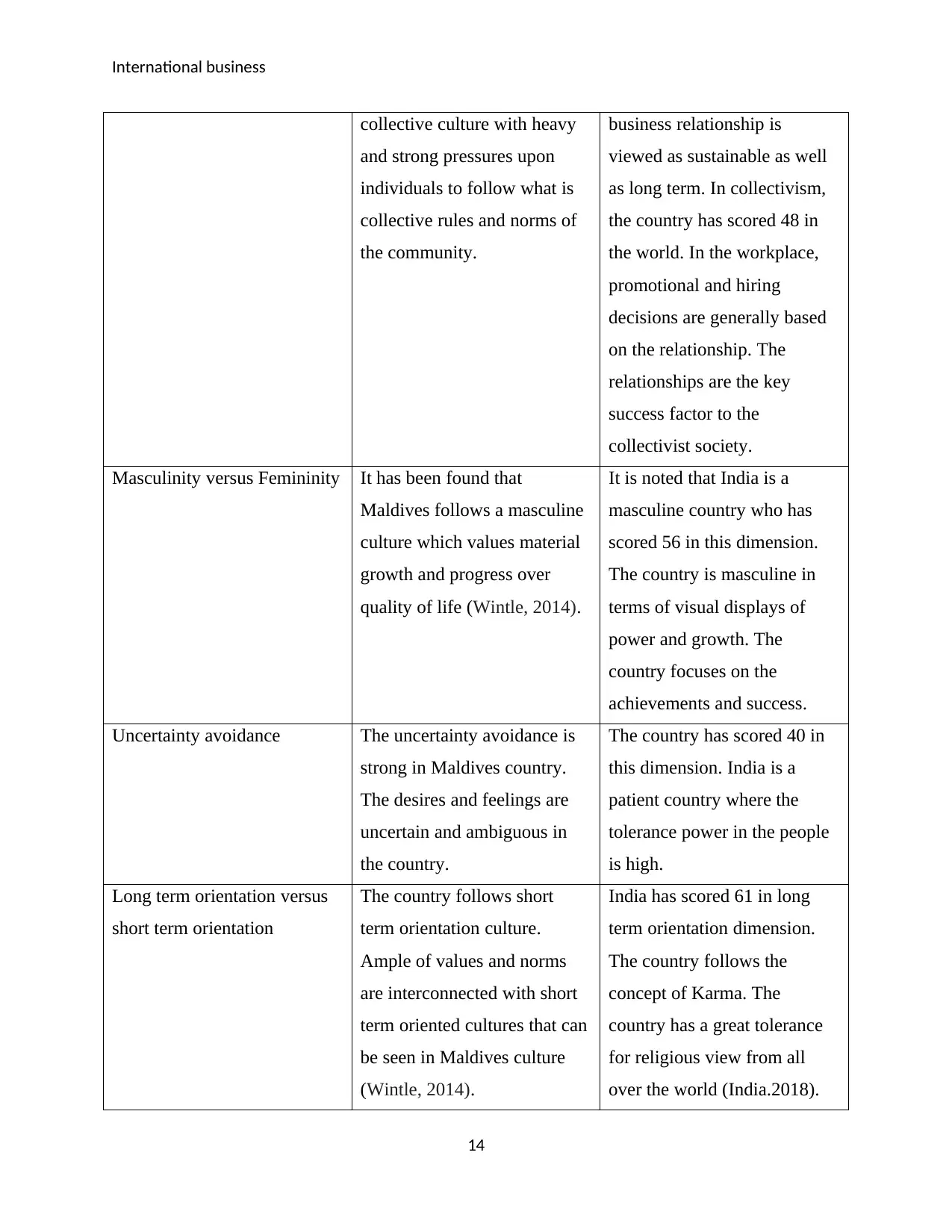
International business
collective culture with heavy
and strong pressures upon
individuals to follow what is
collective rules and norms of
the community.
business relationship is
viewed as sustainable as well
as long term. In collectivism,
the country has scored 48 in
the world. In the workplace,
promotional and hiring
decisions are generally based
on the relationship. The
relationships are the key
success factor to the
collectivist society.
Masculinity versus Femininity It has been found that
Maldives follows a masculine
culture which values material
growth and progress over
quality of life (Wintle, 2014).
It is noted that India is a
masculine country who has
scored 56 in this dimension.
The country is masculine in
terms of visual displays of
power and growth. The
country focuses on the
achievements and success.
Uncertainty avoidance The uncertainty avoidance is
strong in Maldives country.
The desires and feelings are
uncertain and ambiguous in
the country.
The country has scored 40 in
this dimension. India is a
patient country where the
tolerance power in the people
is high.
Long term orientation versus
short term orientation
The country follows short
term orientation culture.
Ample of values and norms
are interconnected with short
term oriented cultures that can
be seen in Maldives culture
(Wintle, 2014).
India has scored 61 in long
term orientation dimension.
The country follows the
concept of Karma. The
country has a great tolerance
for religious view from all
over the world (India.2018).
14
collective culture with heavy
and strong pressures upon
individuals to follow what is
collective rules and norms of
the community.
business relationship is
viewed as sustainable as well
as long term. In collectivism,
the country has scored 48 in
the world. In the workplace,
promotional and hiring
decisions are generally based
on the relationship. The
relationships are the key
success factor to the
collectivist society.
Masculinity versus Femininity It has been found that
Maldives follows a masculine
culture which values material
growth and progress over
quality of life (Wintle, 2014).
It is noted that India is a
masculine country who has
scored 56 in this dimension.
The country is masculine in
terms of visual displays of
power and growth. The
country focuses on the
achievements and success.
Uncertainty avoidance The uncertainty avoidance is
strong in Maldives country.
The desires and feelings are
uncertain and ambiguous in
the country.
The country has scored 40 in
this dimension. India is a
patient country where the
tolerance power in the people
is high.
Long term orientation versus
short term orientation
The country follows short
term orientation culture.
Ample of values and norms
are interconnected with short
term oriented cultures that can
be seen in Maldives culture
(Wintle, 2014).
India has scored 61 in long
term orientation dimension.
The country follows the
concept of Karma. The
country has a great tolerance
for religious view from all
over the world (India.2018).
14
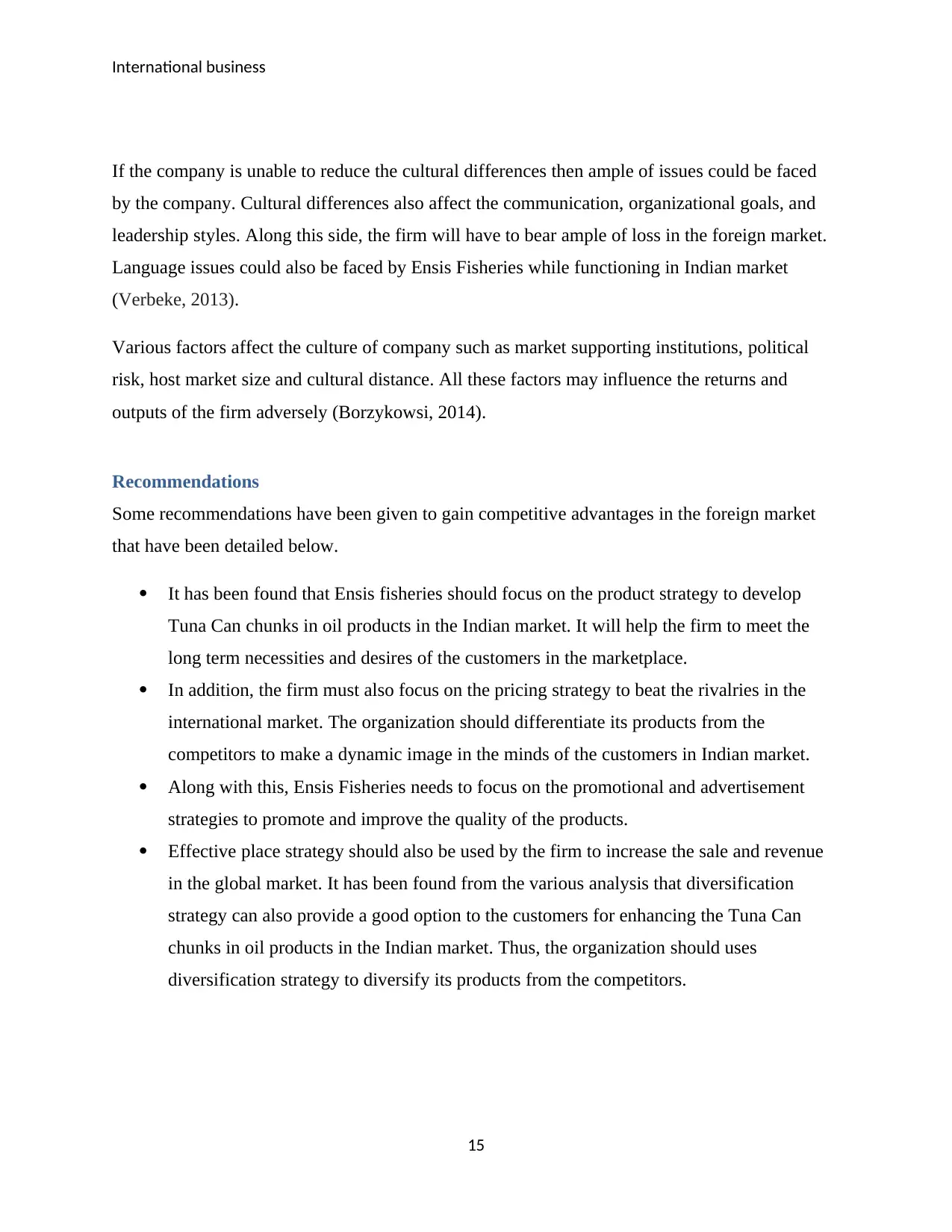
International business
If the company is unable to reduce the cultural differences then ample of issues could be faced
by the company. Cultural differences also affect the communication, organizational goals, and
leadership styles. Along this side, the firm will have to bear ample of loss in the foreign market.
Language issues could also be faced by Ensis Fisheries while functioning in Indian market
(Verbeke, 2013).
Various factors affect the culture of company such as market supporting institutions, political
risk, host market size and cultural distance. All these factors may influence the returns and
outputs of the firm adversely (Borzykowsi, 2014).
Recommendations
Some recommendations have been given to gain competitive advantages in the foreign market
that have been detailed below.
It has been found that Ensis fisheries should focus on the product strategy to develop
Tuna Can chunks in oil products in the Indian market. It will help the firm to meet the
long term necessities and desires of the customers in the marketplace.
In addition, the firm must also focus on the pricing strategy to beat the rivalries in the
international market. The organization should differentiate its products from the
competitors to make a dynamic image in the minds of the customers in Indian market.
Along with this, Ensis Fisheries needs to focus on the promotional and advertisement
strategies to promote and improve the quality of the products.
Effective place strategy should also be used by the firm to increase the sale and revenue
in the global market. It has been found from the various analysis that diversification
strategy can also provide a good option to the customers for enhancing the Tuna Can
chunks in oil products in the Indian market. Thus, the organization should uses
diversification strategy to diversify its products from the competitors.
15
If the company is unable to reduce the cultural differences then ample of issues could be faced
by the company. Cultural differences also affect the communication, organizational goals, and
leadership styles. Along this side, the firm will have to bear ample of loss in the foreign market.
Language issues could also be faced by Ensis Fisheries while functioning in Indian market
(Verbeke, 2013).
Various factors affect the culture of company such as market supporting institutions, political
risk, host market size and cultural distance. All these factors may influence the returns and
outputs of the firm adversely (Borzykowsi, 2014).
Recommendations
Some recommendations have been given to gain competitive advantages in the foreign market
that have been detailed below.
It has been found that Ensis fisheries should focus on the product strategy to develop
Tuna Can chunks in oil products in the Indian market. It will help the firm to meet the
long term necessities and desires of the customers in the marketplace.
In addition, the firm must also focus on the pricing strategy to beat the rivalries in the
international market. The organization should differentiate its products from the
competitors to make a dynamic image in the minds of the customers in Indian market.
Along with this, Ensis Fisheries needs to focus on the promotional and advertisement
strategies to promote and improve the quality of the products.
Effective place strategy should also be used by the firm to increase the sale and revenue
in the global market. It has been found from the various analysis that diversification
strategy can also provide a good option to the customers for enhancing the Tuna Can
chunks in oil products in the Indian market. Thus, the organization should uses
diversification strategy to diversify its products from the competitors.
15
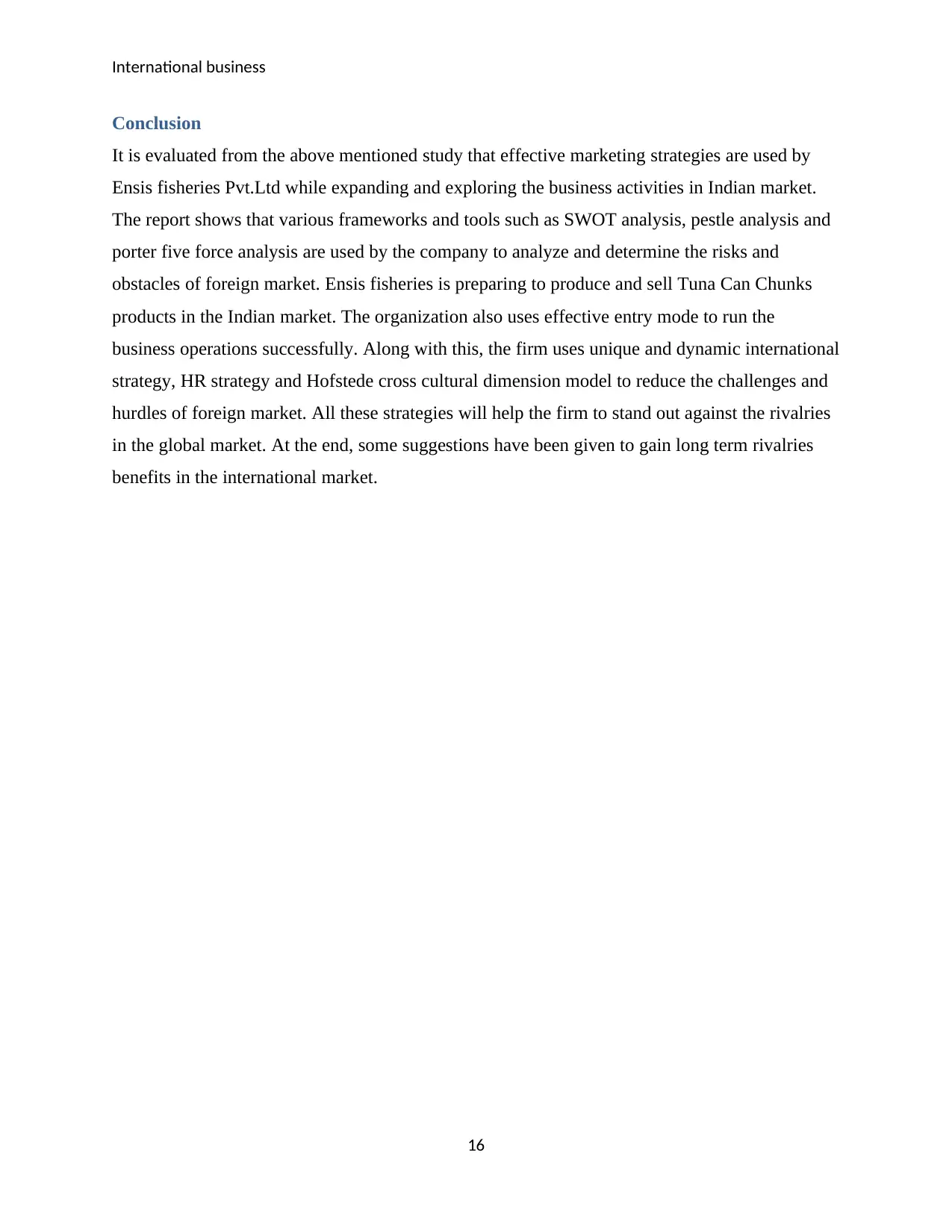
International business
Conclusion
It is evaluated from the above mentioned study that effective marketing strategies are used by
Ensis fisheries Pvt.Ltd while expanding and exploring the business activities in Indian market.
The report shows that various frameworks and tools such as SWOT analysis, pestle analysis and
porter five force analysis are used by the company to analyze and determine the risks and
obstacles of foreign market. Ensis fisheries is preparing to produce and sell Tuna Can Chunks
products in the Indian market. The organization also uses effective entry mode to run the
business operations successfully. Along with this, the firm uses unique and dynamic international
strategy, HR strategy and Hofstede cross cultural dimension model to reduce the challenges and
hurdles of foreign market. All these strategies will help the firm to stand out against the rivalries
in the global market. At the end, some suggestions have been given to gain long term rivalries
benefits in the international market.
16
Conclusion
It is evaluated from the above mentioned study that effective marketing strategies are used by
Ensis fisheries Pvt.Ltd while expanding and exploring the business activities in Indian market.
The report shows that various frameworks and tools such as SWOT analysis, pestle analysis and
porter five force analysis are used by the company to analyze and determine the risks and
obstacles of foreign market. Ensis fisheries is preparing to produce and sell Tuna Can Chunks
products in the Indian market. The organization also uses effective entry mode to run the
business operations successfully. Along with this, the firm uses unique and dynamic international
strategy, HR strategy and Hofstede cross cultural dimension model to reduce the challenges and
hurdles of foreign market. All these strategies will help the firm to stand out against the rivalries
in the global market. At the end, some suggestions have been given to gain long term rivalries
benefits in the international market.
16
Secure Best Marks with AI Grader
Need help grading? Try our AI Grader for instant feedback on your assignments.
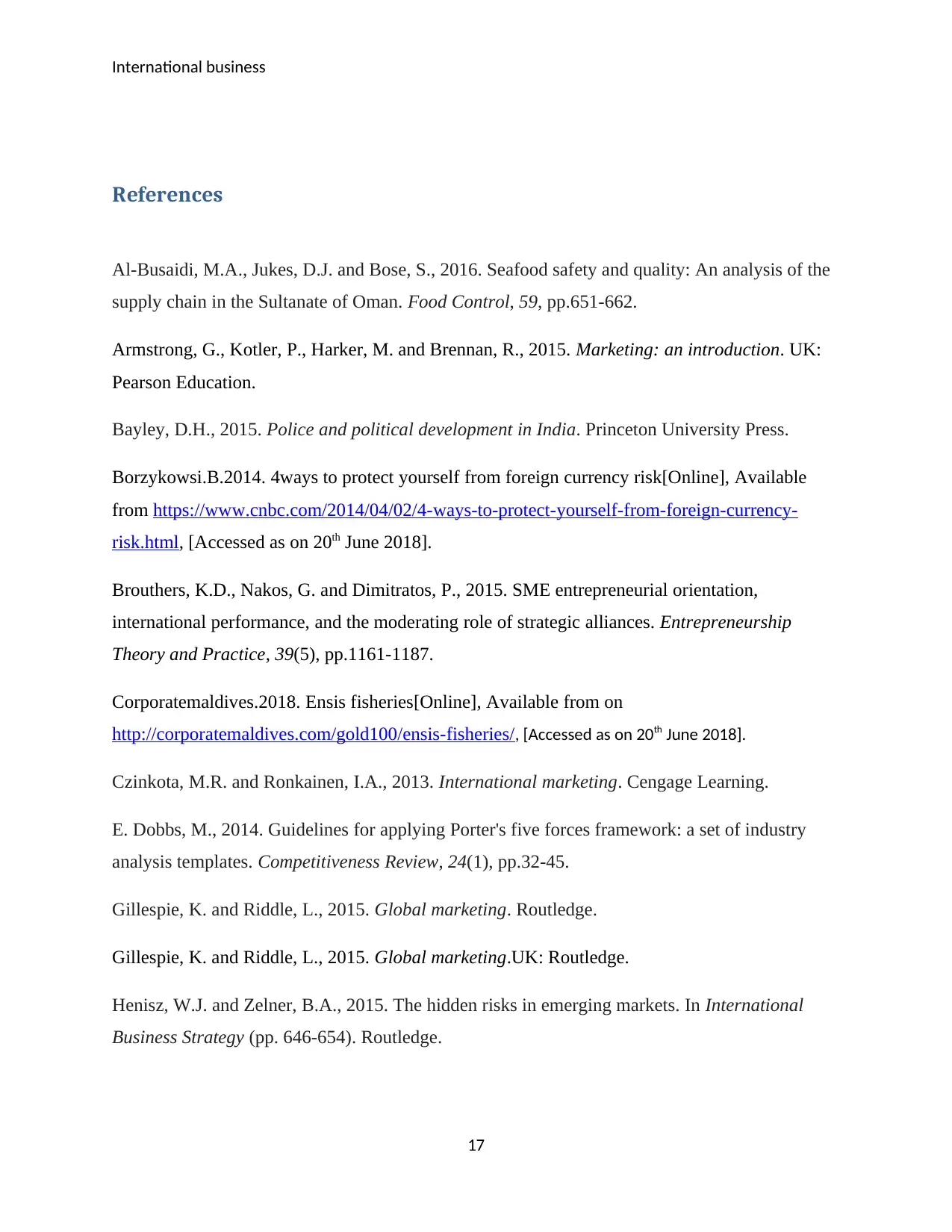
International business
References
Al-Busaidi, M.A., Jukes, D.J. and Bose, S., 2016. Seafood safety and quality: An analysis of the
supply chain in the Sultanate of Oman. Food Control, 59, pp.651-662.
Armstrong, G., Kotler, P., Harker, M. and Brennan, R., 2015. Marketing: an introduction. UK:
Pearson Education.
Bayley, D.H., 2015. Police and political development in India. Princeton University Press.
Borzykowsi.B.2014. 4ways to protect yourself from foreign currency risk[Online], Available
from https://www.cnbc.com/2014/04/02/4-ways-to-protect-yourself-from-foreign-currency-
risk.html, [Accessed as on 20th June 2018].
Brouthers, K.D., Nakos, G. and Dimitratos, P., 2015. SME entrepreneurial orientation,
international performance, and the moderating role of strategic alliances. Entrepreneurship
Theory and Practice, 39(5), pp.1161-1187.
Corporatemaldives.2018. Ensis fisheries[Online], Available from on
http://corporatemaldives.com/gold100/ensis-fisheries/, [Accessed as on 20th June 2018].
Czinkota, M.R. and Ronkainen, I.A., 2013. International marketing. Cengage Learning.
E. Dobbs, M., 2014. Guidelines for applying Porter's five forces framework: a set of industry
analysis templates. Competitiveness Review, 24(1), pp.32-45.
Gillespie, K. and Riddle, L., 2015. Global marketing. Routledge.
Gillespie, K. and Riddle, L., 2015. Global marketing.UK: Routledge.
Henisz, W.J. and Zelner, B.A., 2015. The hidden risks in emerging markets. In International
Business Strategy (pp. 646-654). Routledge.
17
References
Al-Busaidi, M.A., Jukes, D.J. and Bose, S., 2016. Seafood safety and quality: An analysis of the
supply chain in the Sultanate of Oman. Food Control, 59, pp.651-662.
Armstrong, G., Kotler, P., Harker, M. and Brennan, R., 2015. Marketing: an introduction. UK:
Pearson Education.
Bayley, D.H., 2015. Police and political development in India. Princeton University Press.
Borzykowsi.B.2014. 4ways to protect yourself from foreign currency risk[Online], Available
from https://www.cnbc.com/2014/04/02/4-ways-to-protect-yourself-from-foreign-currency-
risk.html, [Accessed as on 20th June 2018].
Brouthers, K.D., Nakos, G. and Dimitratos, P., 2015. SME entrepreneurial orientation,
international performance, and the moderating role of strategic alliances. Entrepreneurship
Theory and Practice, 39(5), pp.1161-1187.
Corporatemaldives.2018. Ensis fisheries[Online], Available from on
http://corporatemaldives.com/gold100/ensis-fisheries/, [Accessed as on 20th June 2018].
Czinkota, M.R. and Ronkainen, I.A., 2013. International marketing. Cengage Learning.
E. Dobbs, M., 2014. Guidelines for applying Porter's five forces framework: a set of industry
analysis templates. Competitiveness Review, 24(1), pp.32-45.
Gillespie, K. and Riddle, L., 2015. Global marketing. Routledge.
Gillespie, K. and Riddle, L., 2015. Global marketing.UK: Routledge.
Henisz, W.J. and Zelner, B.A., 2015. The hidden risks in emerging markets. In International
Business Strategy (pp. 646-654). Routledge.
17
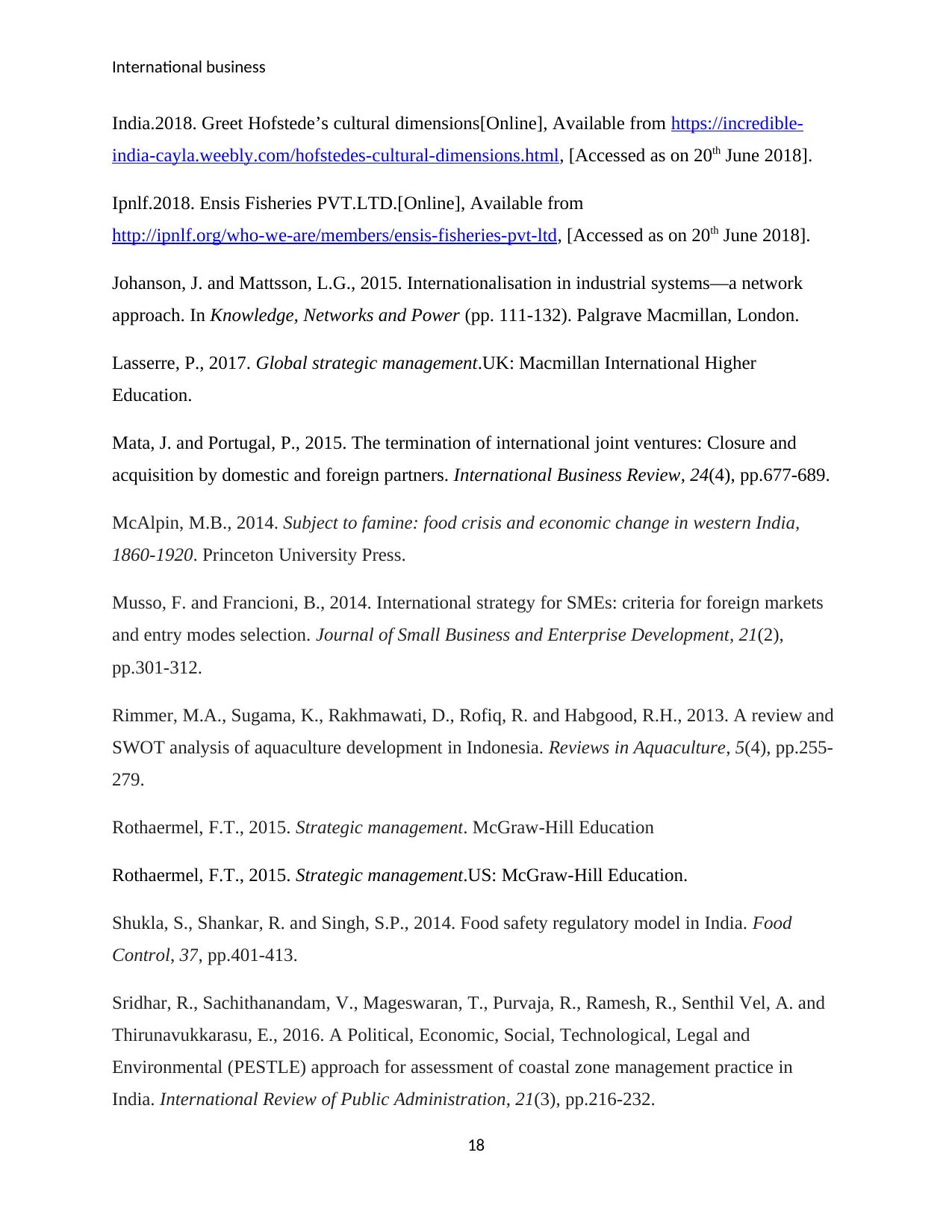
International business
India.2018. Greet Hofstede’s cultural dimensions[Online], Available from https://incredible-
india-cayla.weebly.com/hofstedes-cultural-dimensions.html, [Accessed as on 20th June 2018].
Ipnlf.2018. Ensis Fisheries PVT.LTD.[Online], Available from
http://ipnlf.org/who-we-are/members/ensis-fisheries-pvt-ltd, [Accessed as on 20th June 2018].
Johanson, J. and Mattsson, L.G., 2015. Internationalisation in industrial systems—a network
approach. In Knowledge, Networks and Power (pp. 111-132). Palgrave Macmillan, London.
Lasserre, P., 2017. Global strategic management.UK: Macmillan International Higher
Education.
Mata, J. and Portugal, P., 2015. The termination of international joint ventures: Closure and
acquisition by domestic and foreign partners. International Business Review, 24(4), pp.677-689.
McAlpin, M.B., 2014. Subject to famine: food crisis and economic change in western India,
1860-1920. Princeton University Press.
Musso, F. and Francioni, B., 2014. International strategy for SMEs: criteria for foreign markets
and entry modes selection. Journal of Small Business and Enterprise Development, 21(2),
pp.301-312.
Rimmer, M.A., Sugama, K., Rakhmawati, D., Rofiq, R. and Habgood, R.H., 2013. A review and
SWOT analysis of aquaculture development in Indonesia. Reviews in Aquaculture, 5(4), pp.255-
279.
Rothaermel, F.T., 2015. Strategic management. McGraw-Hill Education
Rothaermel, F.T., 2015. Strategic management.US: McGraw-Hill Education.
Shukla, S., Shankar, R. and Singh, S.P., 2014. Food safety regulatory model in India. Food
Control, 37, pp.401-413.
Sridhar, R., Sachithanandam, V., Mageswaran, T., Purvaja, R., Ramesh, R., Senthil Vel, A. and
Thirunavukkarasu, E., 2016. A Political, Economic, Social, Technological, Legal and
Environmental (PESTLE) approach for assessment of coastal zone management practice in
India. International Review of Public Administration, 21(3), pp.216-232.
18
India.2018. Greet Hofstede’s cultural dimensions[Online], Available from https://incredible-
india-cayla.weebly.com/hofstedes-cultural-dimensions.html, [Accessed as on 20th June 2018].
Ipnlf.2018. Ensis Fisheries PVT.LTD.[Online], Available from
http://ipnlf.org/who-we-are/members/ensis-fisheries-pvt-ltd, [Accessed as on 20th June 2018].
Johanson, J. and Mattsson, L.G., 2015. Internationalisation in industrial systems—a network
approach. In Knowledge, Networks and Power (pp. 111-132). Palgrave Macmillan, London.
Lasserre, P., 2017. Global strategic management.UK: Macmillan International Higher
Education.
Mata, J. and Portugal, P., 2015. The termination of international joint ventures: Closure and
acquisition by domestic and foreign partners. International Business Review, 24(4), pp.677-689.
McAlpin, M.B., 2014. Subject to famine: food crisis and economic change in western India,
1860-1920. Princeton University Press.
Musso, F. and Francioni, B., 2014. International strategy for SMEs: criteria for foreign markets
and entry modes selection. Journal of Small Business and Enterprise Development, 21(2),
pp.301-312.
Rimmer, M.A., Sugama, K., Rakhmawati, D., Rofiq, R. and Habgood, R.H., 2013. A review and
SWOT analysis of aquaculture development in Indonesia. Reviews in Aquaculture, 5(4), pp.255-
279.
Rothaermel, F.T., 2015. Strategic management. McGraw-Hill Education
Rothaermel, F.T., 2015. Strategic management.US: McGraw-Hill Education.
Shukla, S., Shankar, R. and Singh, S.P., 2014. Food safety regulatory model in India. Food
Control, 37, pp.401-413.
Sridhar, R., Sachithanandam, V., Mageswaran, T., Purvaja, R., Ramesh, R., Senthil Vel, A. and
Thirunavukkarasu, E., 2016. A Political, Economic, Social, Technological, Legal and
Environmental (PESTLE) approach for assessment of coastal zone management practice in
India. International Review of Public Administration, 21(3), pp.216-232.
18
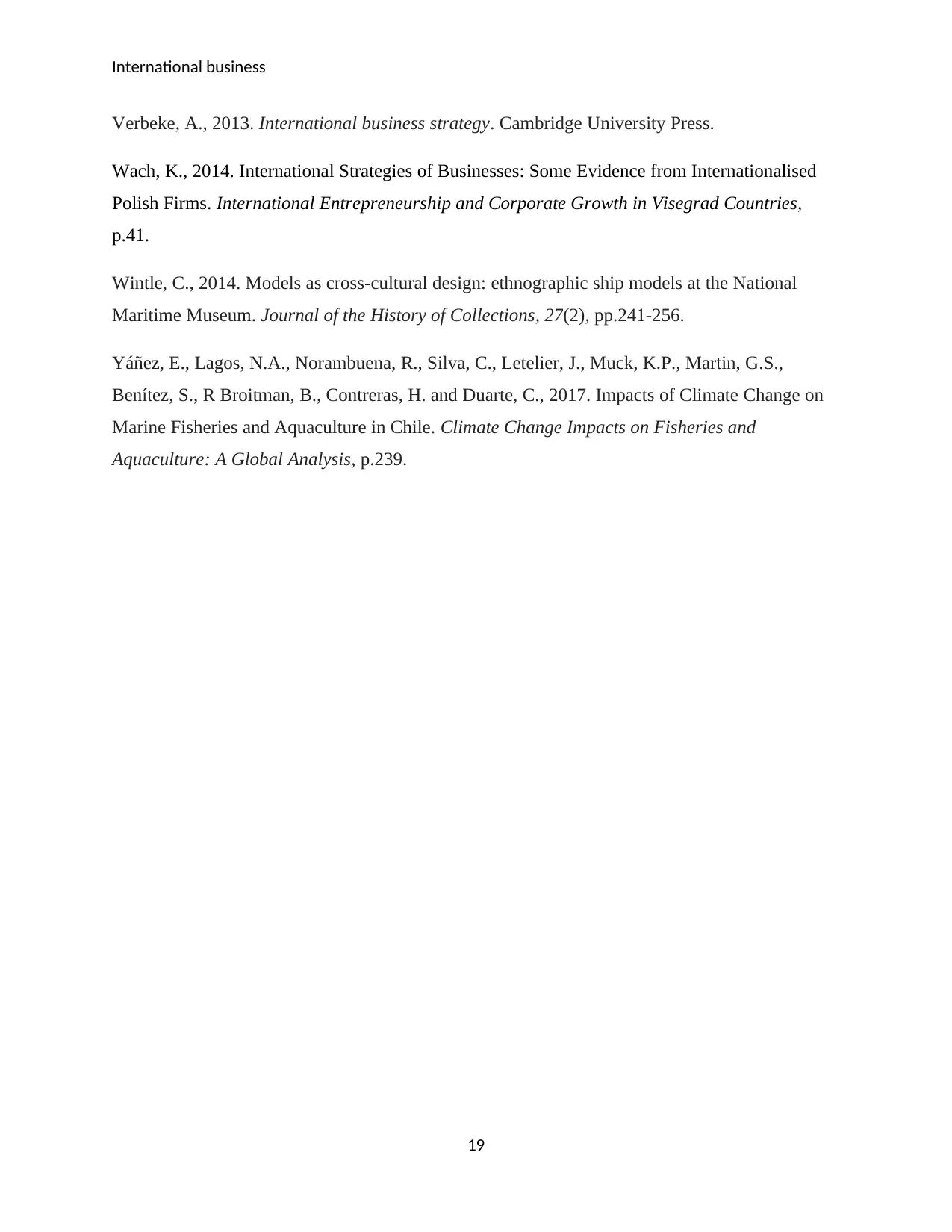
International business
Verbeke, A., 2013. International business strategy. Cambridge University Press.
Wach, K., 2014. International Strategies of Businesses: Some Evidence from Internationalised
Polish Firms. International Entrepreneurship and Corporate Growth in Visegrad Countries,
p.41.
Wintle, C., 2014. Models as cross-cultural design: ethnographic ship models at the National
Maritime Museum. Journal of the History of Collections, 27(2), pp.241-256.
Yáñez, E., Lagos, N.A., Norambuena, R., Silva, C., Letelier, J., Muck, K.P., Martin, G.S.,
Benítez, S., R Broitman, B., Contreras, H. and Duarte, C., 2017. Impacts of Climate Change on
Marine Fisheries and Aquaculture in Chile. Climate Change Impacts on Fisheries and
Aquaculture: A Global Analysis, p.239.
19
Verbeke, A., 2013. International business strategy. Cambridge University Press.
Wach, K., 2014. International Strategies of Businesses: Some Evidence from Internationalised
Polish Firms. International Entrepreneurship and Corporate Growth in Visegrad Countries,
p.41.
Wintle, C., 2014. Models as cross-cultural design: ethnographic ship models at the National
Maritime Museum. Journal of the History of Collections, 27(2), pp.241-256.
Yáñez, E., Lagos, N.A., Norambuena, R., Silva, C., Letelier, J., Muck, K.P., Martin, G.S.,
Benítez, S., R Broitman, B., Contreras, H. and Duarte, C., 2017. Impacts of Climate Change on
Marine Fisheries and Aquaculture in Chile. Climate Change Impacts on Fisheries and
Aquaculture: A Global Analysis, p.239.
19
Paraphrase This Document
Need a fresh take? Get an instant paraphrase of this document with our AI Paraphraser

International business
Bibliography
Sadiq, A., 2018. A study of the impact of national culture on transformational leadership
practices in the Maldives. AU Journal of Management, 9(2), pp.1-11.
Hassan, Z., 2016. Influence of Customer Perceived Value on Tourist Satisfaction and Revisit
Intention: A Study on Guesthouses in Maldives.
Gutehall, S., 2013. Health Services Marketing in a Cross-Cultural Environment: Elekta in Hong
Kong.
Bryman, A. and Bell, E., 2015. Business research methods. Oxford University Press, USA.
Seitanidi, M.M. and Crane, A. eds., 2013. Social partnerships and responsible business: A
research handbook. Routledge.
Gërxhani, K. and Koster, F., 2015. Making the right move. Investigating employers’ recruitment
strategies. Personnel Review, 44(5), pp.781-800.
Tarique, I., Briscoe, D.R. and Schuler, R.S., 2015. International human resource management:
Policies and practices for multinational enterprises. Routledge.
Armstrong, G., Kotler, P., Harker, M. and Brennan, R., 2015. Marketing: an introduction. UK:
Pearson Education.
Brouthers, K.D., Nakos, G. and Dimitratos, P., 2015. SME entrepreneurial orientation,
international performance, and the moderating role of strategic alliances. Entrepreneurship
Theory and Practice, 39(5), pp.1161-1187.
Gillespie, K. and Riddle, L., 2015. Global marketing.UK: Routledge.
Johanson, J. and Mattsson, L.G., 2015. Internationalisation in industrial systems—a network
approach. In Knowledge, Networks and Power (pp. 111-132). Palgrave Macmillan, London.
20
Bibliography
Sadiq, A., 2018. A study of the impact of national culture on transformational leadership
practices in the Maldives. AU Journal of Management, 9(2), pp.1-11.
Hassan, Z., 2016. Influence of Customer Perceived Value on Tourist Satisfaction and Revisit
Intention: A Study on Guesthouses in Maldives.
Gutehall, S., 2013. Health Services Marketing in a Cross-Cultural Environment: Elekta in Hong
Kong.
Bryman, A. and Bell, E., 2015. Business research methods. Oxford University Press, USA.
Seitanidi, M.M. and Crane, A. eds., 2013. Social partnerships and responsible business: A
research handbook. Routledge.
Gërxhani, K. and Koster, F., 2015. Making the right move. Investigating employers’ recruitment
strategies. Personnel Review, 44(5), pp.781-800.
Tarique, I., Briscoe, D.R. and Schuler, R.S., 2015. International human resource management:
Policies and practices for multinational enterprises. Routledge.
Armstrong, G., Kotler, P., Harker, M. and Brennan, R., 2015. Marketing: an introduction. UK:
Pearson Education.
Brouthers, K.D., Nakos, G. and Dimitratos, P., 2015. SME entrepreneurial orientation,
international performance, and the moderating role of strategic alliances. Entrepreneurship
Theory and Practice, 39(5), pp.1161-1187.
Gillespie, K. and Riddle, L., 2015. Global marketing.UK: Routledge.
Johanson, J. and Mattsson, L.G., 2015. Internationalisation in industrial systems—a network
approach. In Knowledge, Networks and Power (pp. 111-132). Palgrave Macmillan, London.
20
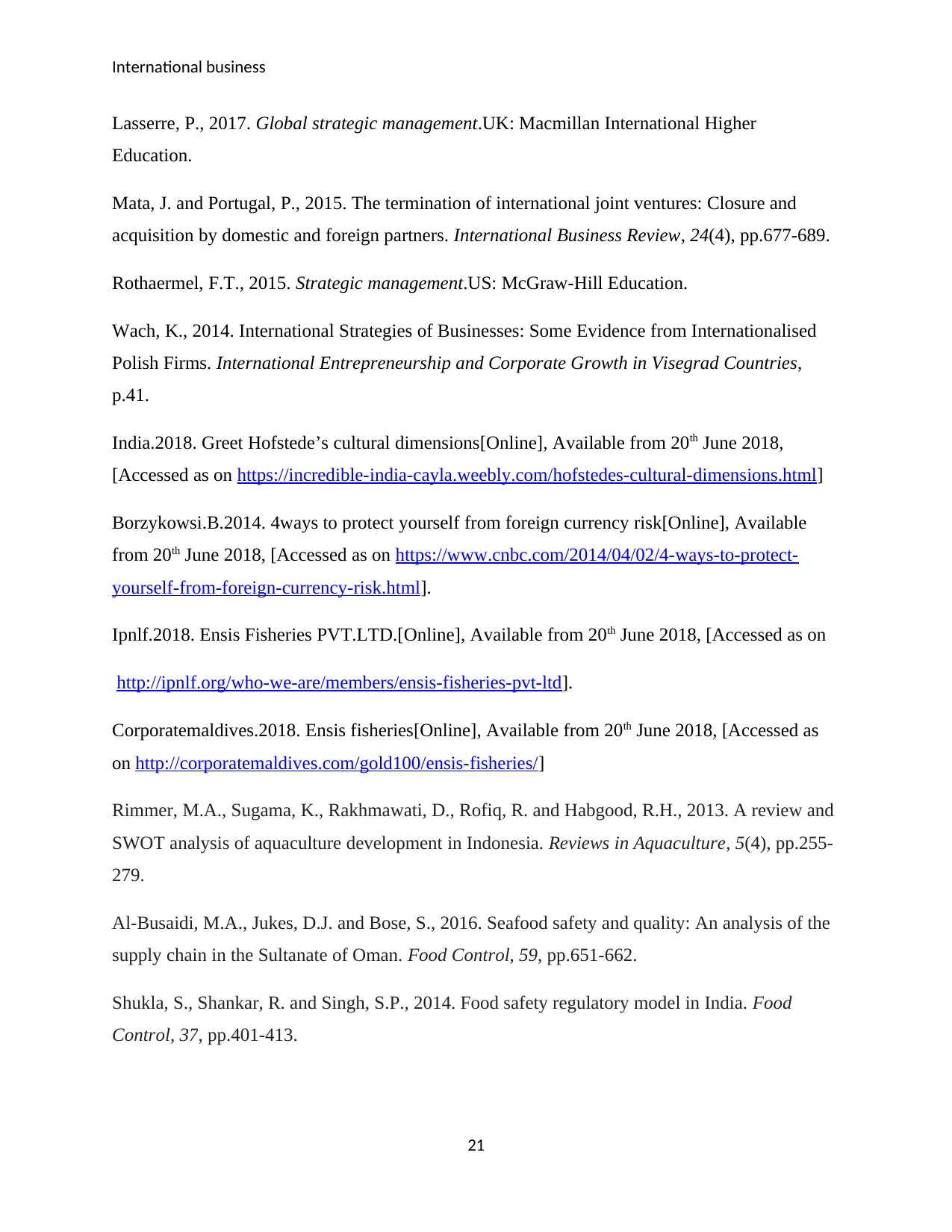
International business
Lasserre, P., 2017. Global strategic management.UK: Macmillan International Higher
Education.
Mata, J. and Portugal, P., 2015. The termination of international joint ventures: Closure and
acquisition by domestic and foreign partners. International Business Review, 24(4), pp.677-689.
Rothaermel, F.T., 2015. Strategic management.US: McGraw-Hill Education.
Wach, K., 2014. International Strategies of Businesses: Some Evidence from Internationalised
Polish Firms. International Entrepreneurship and Corporate Growth in Visegrad Countries,
p.41.
India.2018. Greet Hofstede’s cultural dimensions[Online], Available from 20th June 2018,
[Accessed as on https://incredible-india-cayla.weebly.com/hofstedes-cultural-dimensions.html]
Borzykowsi.B.2014. 4ways to protect yourself from foreign currency risk[Online], Available
from 20th June 2018, [Accessed as on https://www.cnbc.com/2014/04/02/4-ways-to-protect-
yourself-from-foreign-currency-risk.html].
Ipnlf.2018. Ensis Fisheries PVT.LTD.[Online], Available from 20th June 2018, [Accessed as on
http://ipnlf.org/who-we-are/members/ensis-fisheries-pvt-ltd].
Corporatemaldives.2018. Ensis fisheries[Online], Available from 20th June 2018, [Accessed as
on http://corporatemaldives.com/gold100/ensis-fisheries/]
Rimmer, M.A., Sugama, K., Rakhmawati, D., Rofiq, R. and Habgood, R.H., 2013. A review and
SWOT analysis of aquaculture development in Indonesia. Reviews in Aquaculture, 5(4), pp.255-
279.
Al-Busaidi, M.A., Jukes, D.J. and Bose, S., 2016. Seafood safety and quality: An analysis of the
supply chain in the Sultanate of Oman. Food Control, 59, pp.651-662.
Shukla, S., Shankar, R. and Singh, S.P., 2014. Food safety regulatory model in India. Food
Control, 37, pp.401-413.
21
Lasserre, P., 2017. Global strategic management.UK: Macmillan International Higher
Education.
Mata, J. and Portugal, P., 2015. The termination of international joint ventures: Closure and
acquisition by domestic and foreign partners. International Business Review, 24(4), pp.677-689.
Rothaermel, F.T., 2015. Strategic management.US: McGraw-Hill Education.
Wach, K., 2014. International Strategies of Businesses: Some Evidence from Internationalised
Polish Firms. International Entrepreneurship and Corporate Growth in Visegrad Countries,
p.41.
India.2018. Greet Hofstede’s cultural dimensions[Online], Available from 20th June 2018,
[Accessed as on https://incredible-india-cayla.weebly.com/hofstedes-cultural-dimensions.html]
Borzykowsi.B.2014. 4ways to protect yourself from foreign currency risk[Online], Available
from 20th June 2018, [Accessed as on https://www.cnbc.com/2014/04/02/4-ways-to-protect-
yourself-from-foreign-currency-risk.html].
Ipnlf.2018. Ensis Fisheries PVT.LTD.[Online], Available from 20th June 2018, [Accessed as on
http://ipnlf.org/who-we-are/members/ensis-fisheries-pvt-ltd].
Corporatemaldives.2018. Ensis fisheries[Online], Available from 20th June 2018, [Accessed as
on http://corporatemaldives.com/gold100/ensis-fisheries/]
Rimmer, M.A., Sugama, K., Rakhmawati, D., Rofiq, R. and Habgood, R.H., 2013. A review and
SWOT analysis of aquaculture development in Indonesia. Reviews in Aquaculture, 5(4), pp.255-
279.
Al-Busaidi, M.A., Jukes, D.J. and Bose, S., 2016. Seafood safety and quality: An analysis of the
supply chain in the Sultanate of Oman. Food Control, 59, pp.651-662.
Shukla, S., Shankar, R. and Singh, S.P., 2014. Food safety regulatory model in India. Food
Control, 37, pp.401-413.
21

International business
Sridhar, R., Sachithanandam, V., Mageswaran, T., Purvaja, R., Ramesh, R., Senthil Vel, A. and
Thirunavukkarasu, E., 2016. A Political, Economic, Social, Technological, Legal and
Environmental (PESTLE) approach for assessment of coastal zone management practice in
India. International Review of Public Administration, 21(3), pp.216-232.
Bayley, D.H., 2015. Police and political development in India. Princeton University Press.
McAlpin, M.B., 2014. Subject to famine: food crisis and economic change in western India,
1860-1920. Princeton University Press.
Yáñez, E., Lagos, N.A., Norambuena, R., Silva, C., Letelier, J., Muck, K.P., Martin, G.S.,
Benítez, S., R Broitman, B., Contreras, H. and Duarte, C., 2017. Impacts of Climate Change on
Marine Fisheries and Aquaculture in Chile. Climate Change Impacts on Fisheries and
Aquaculture: A Global Analysis, p.239.
E. Dobbs, M., 2014. Guidelines for applying Porter's five forces framework: a set of industry
analysis templates. Competitiveness Review, 24(1), pp.32-45.
Rothaermel, F.T., 2015. Strategic management. McGraw-Hill Education
Czinkota, M.R. and Ronkainen, I.A., 2013. International marketing. Cengage Learning.
Henisz, W.J. and Zelner, B.A., 2015. The hidden risks in emerging markets. In International
Business Strategy (pp. 646-654). Routledge.
Gillespie, K. and Riddle, L., 2015. Global marketing. Routledge.
Verbeke, A., 2013. International business strategy. Cambridge University Press.
Musso, F. and Francioni, B., 2014. International strategy for SMEs: criteria for foreign markets
and entry modes selection. Journal of Small Business and Enterprise Development, 21(2),
pp.301-312.
Wintle, C., 2014. Models as cross-cultural design: ethnographic ship models at the National
Maritime Museum. Journal of the History of Collections, 27(2), pp.241-256.
22
Sridhar, R., Sachithanandam, V., Mageswaran, T., Purvaja, R., Ramesh, R., Senthil Vel, A. and
Thirunavukkarasu, E., 2016. A Political, Economic, Social, Technological, Legal and
Environmental (PESTLE) approach for assessment of coastal zone management practice in
India. International Review of Public Administration, 21(3), pp.216-232.
Bayley, D.H., 2015. Police and political development in India. Princeton University Press.
McAlpin, M.B., 2014. Subject to famine: food crisis and economic change in western India,
1860-1920. Princeton University Press.
Yáñez, E., Lagos, N.A., Norambuena, R., Silva, C., Letelier, J., Muck, K.P., Martin, G.S.,
Benítez, S., R Broitman, B., Contreras, H. and Duarte, C., 2017. Impacts of Climate Change on
Marine Fisheries and Aquaculture in Chile. Climate Change Impacts on Fisheries and
Aquaculture: A Global Analysis, p.239.
E. Dobbs, M., 2014. Guidelines for applying Porter's five forces framework: a set of industry
analysis templates. Competitiveness Review, 24(1), pp.32-45.
Rothaermel, F.T., 2015. Strategic management. McGraw-Hill Education
Czinkota, M.R. and Ronkainen, I.A., 2013. International marketing. Cengage Learning.
Henisz, W.J. and Zelner, B.A., 2015. The hidden risks in emerging markets. In International
Business Strategy (pp. 646-654). Routledge.
Gillespie, K. and Riddle, L., 2015. Global marketing. Routledge.
Verbeke, A., 2013. International business strategy. Cambridge University Press.
Musso, F. and Francioni, B., 2014. International strategy for SMEs: criteria for foreign markets
and entry modes selection. Journal of Small Business and Enterprise Development, 21(2),
pp.301-312.
Wintle, C., 2014. Models as cross-cultural design: ethnographic ship models at the National
Maritime Museum. Journal of the History of Collections, 27(2), pp.241-256.
22
Secure Best Marks with AI Grader
Need help grading? Try our AI Grader for instant feedback on your assignments.

International business
23
23
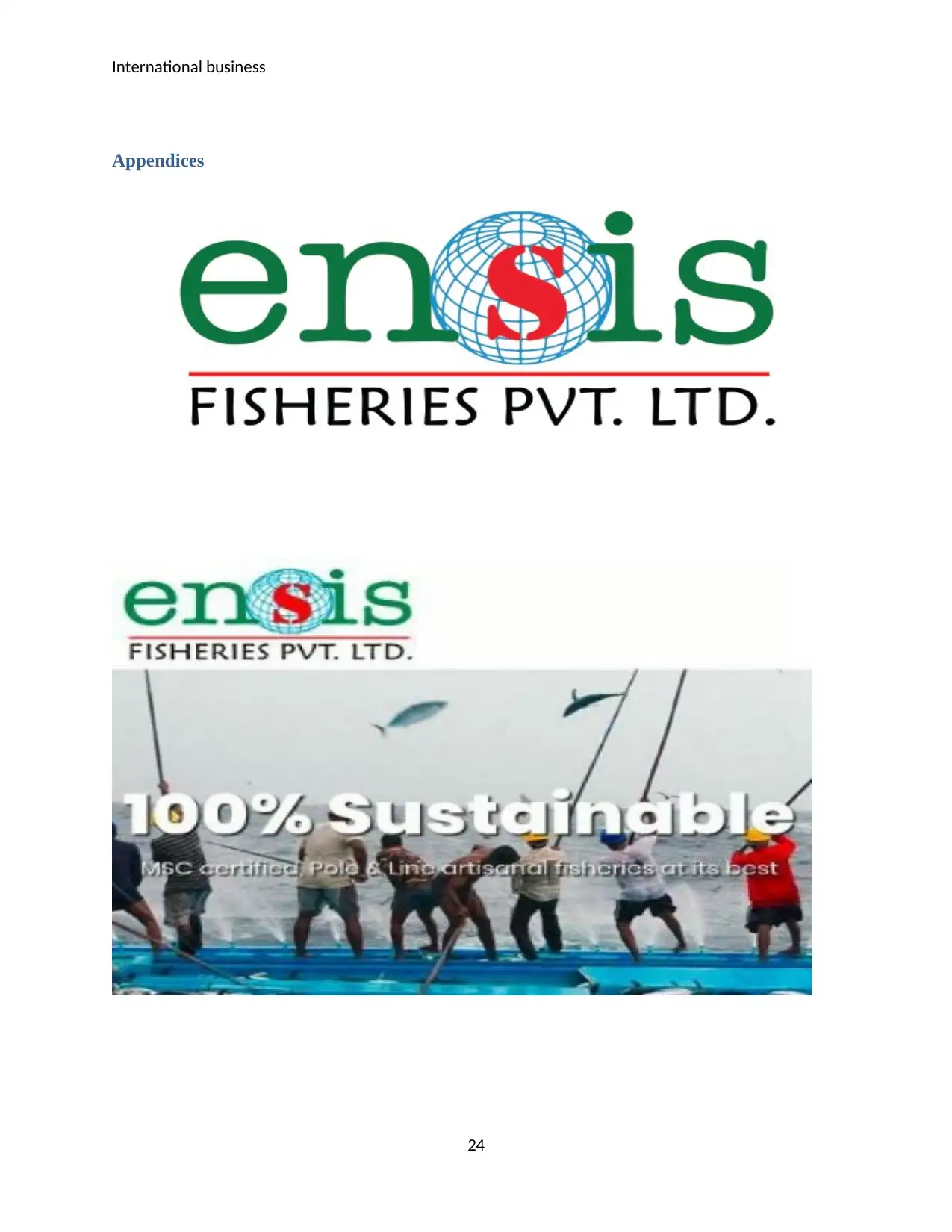
International business
Appendices
24
Appendices
24
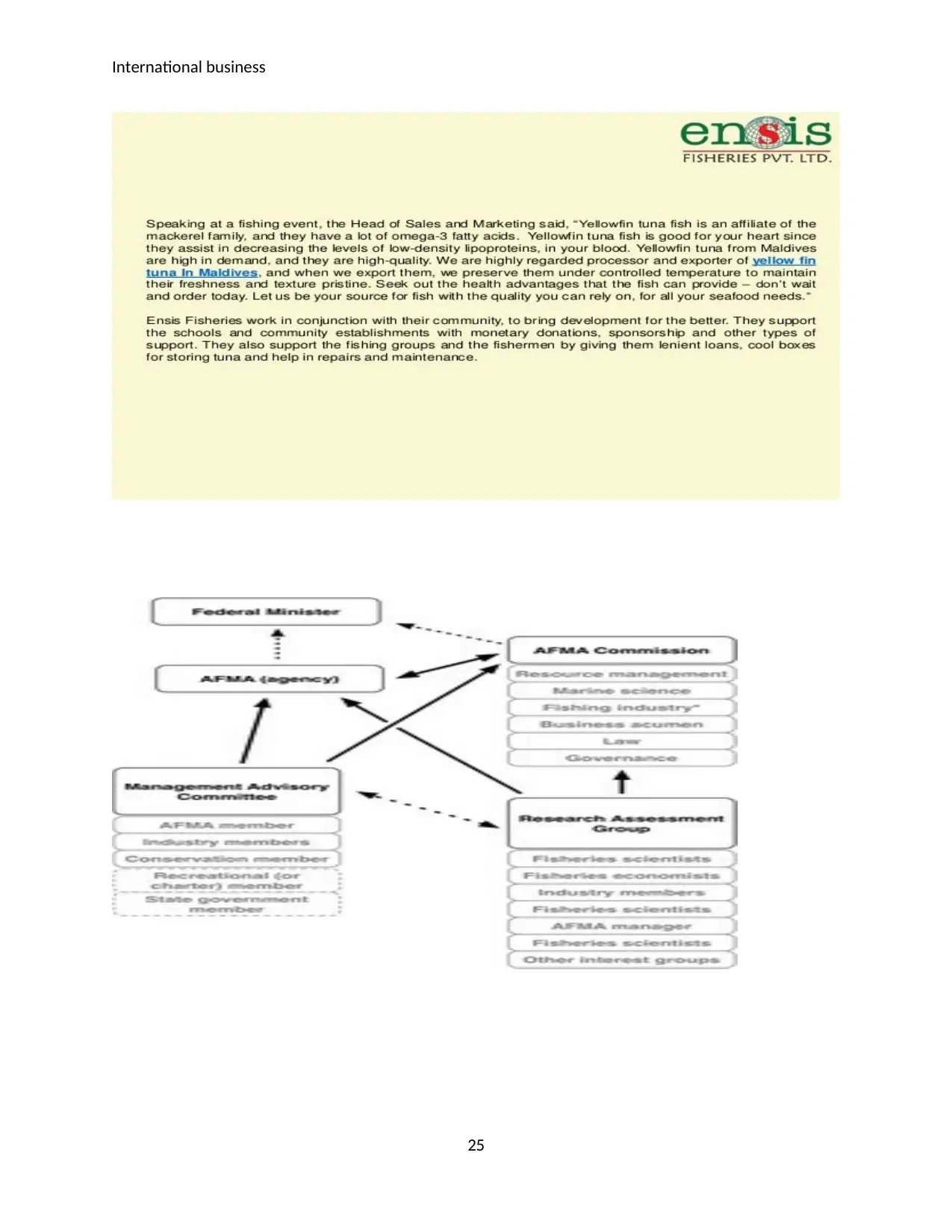
International business
25
25
Paraphrase This Document
Need a fresh take? Get an instant paraphrase of this document with our AI Paraphraser
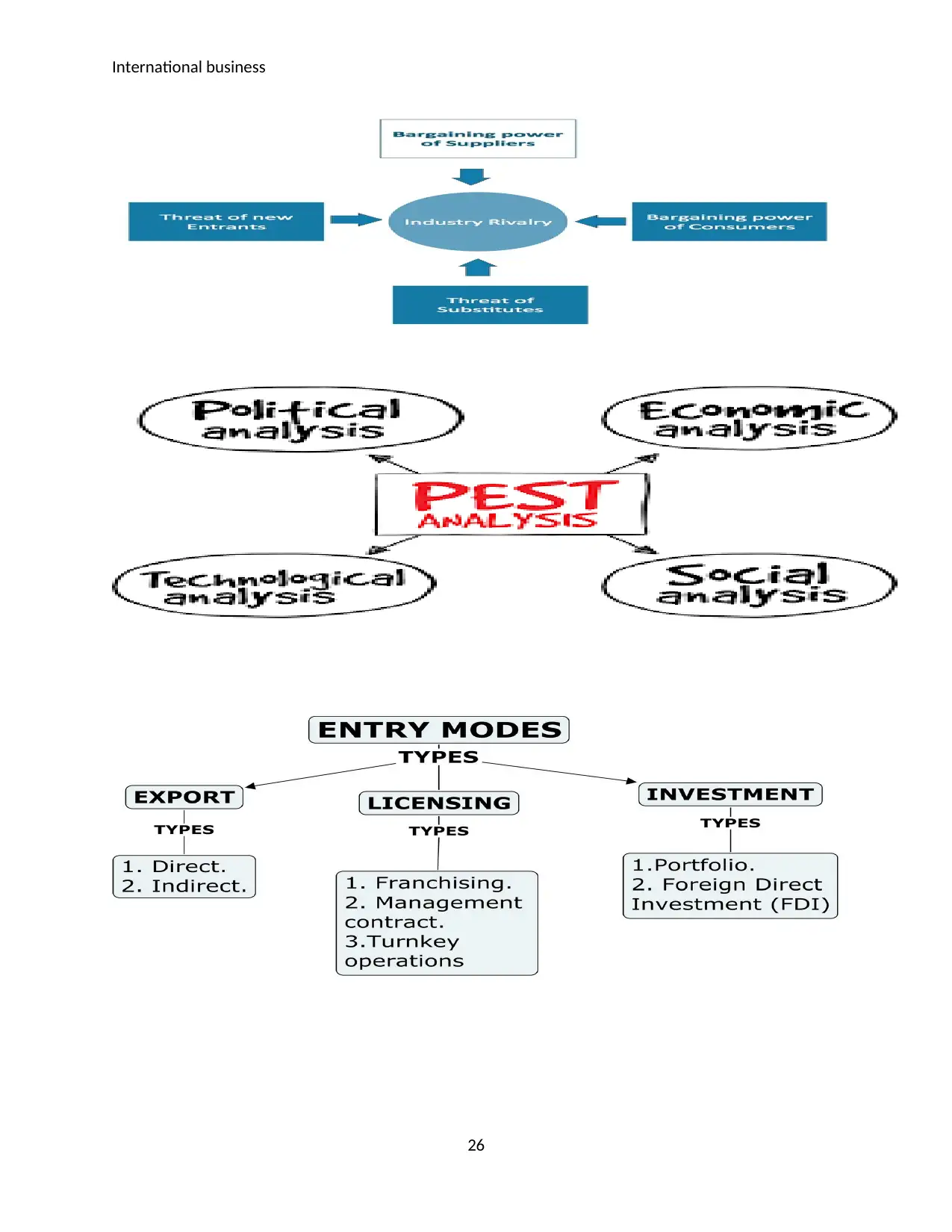
International business
26
26

International business
27
27
1 out of 27
Related Documents
Your All-in-One AI-Powered Toolkit for Academic Success.
+13062052269
info@desklib.com
Available 24*7 on WhatsApp / Email
![[object Object]](/_next/static/media/star-bottom.7253800d.svg)
Unlock your academic potential
© 2024 | Zucol Services PVT LTD | All rights reserved.



